

Free Self-Guided Walking Tour of Jerusalem’s Old City (with Map)
The Old City of Jerusalem is an amazing site and amazingly small when you consider all the significant sites it contains. It is around one square kilometer. I had a chance to visit Jerusalem for the first time recently when I attended the TBEX conference there. While I was there I took a walking tour from Sandeman . This is what I learned on that tour and on my own explorations.
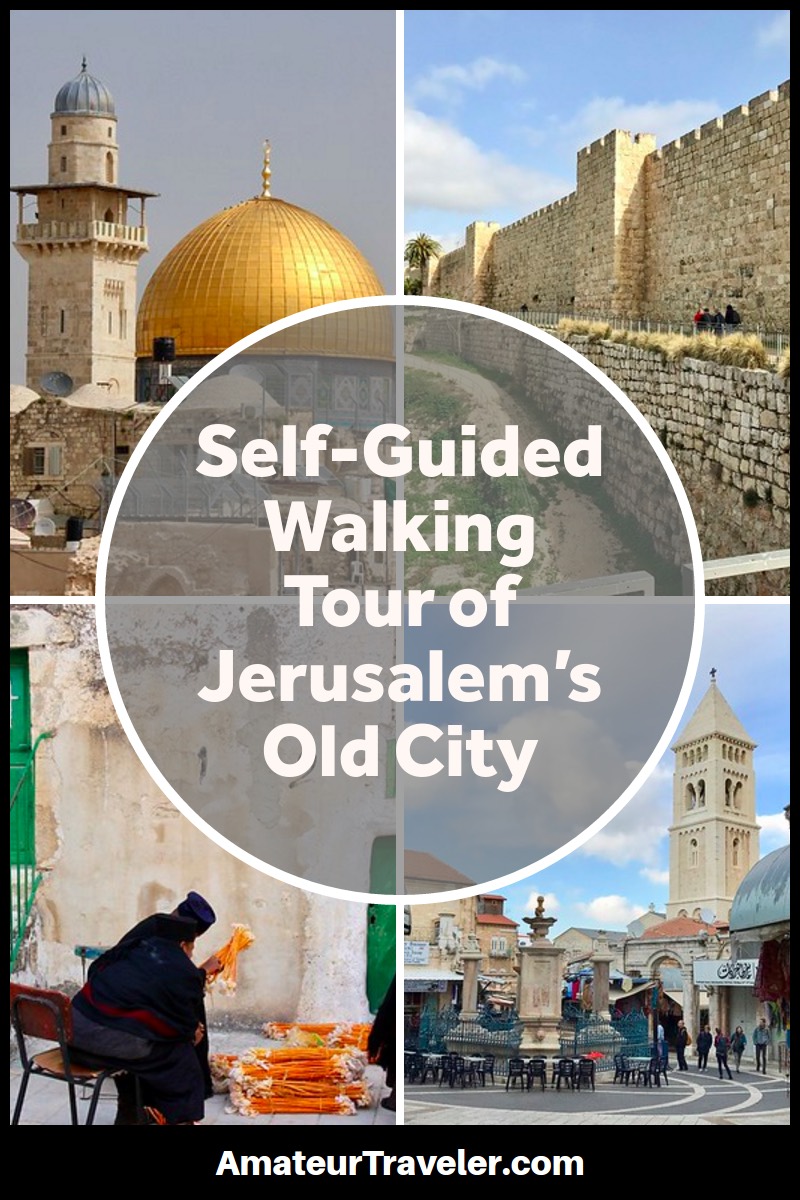
The Ancient Walled City
The jaffa gate, the tower of david, the armenian quarter, the roman cardo, the jewish quarter, the temple mount, david street, christian quarter, church of the holy sepulcher, guided tours, map self-guided walking tour of jerusalem’s old city.

Jerusalem has been conquered by a great number of civilizations over the centuries including the Babylonians, the Romans, the Arabs, the Crusaders, the Turks, and the British. When you look at the old walled city today you are looking at the walls built later in the cities history, completed in 1541 by the Ottoman ruler Suleiman the Magnificent. You can get a good view of the city by walking these walls.
For centuries after these walls were built, they defined the extent of the city of Jerusalem as people were afraid to live outside of the protection of the walls. The new city did not really get started until 1860 and at first, people had to be paid to live outside the safety of the walls.

Most tourists will enter the city on the west side through the Jaffa Gate. Just inside the Jaffa gate to the left is one of the entry places where you can start a walk along the walls.
If you have questions the tourism information center is also just inside that entrance. Pick up a free map, because you will need it. If you don’t have a data service download a good offline map like those from maps.me on your smartphone before you leave your hotel or hostel .

When I was visiting the city, they were doing a series of free concerts in the evenings and had stages both inside and outside of the Jaffa Gate.

Just to the left of the Jaffa gate, you will see the tower of David, which has nothing to do with King David. Early pilgrims visiting the city read in their bibles that David built a tower and assumed that this must be it, but David’s city is outside the old walls to the south and down the hill from the old city. You can now visit the archaeological site where they are uncovering this city just outside the Dung Gate. You can also visit David’s tomb just outside of the Zion Gate.
This tower was first built by Herod the Great who also rebuilt the temple just before the time of Christ. Look at this tower closely and you will see signs of 3 different eras. The base of the tower was built by Herod, the moat around it by the crusaders and the top of the tower by the Mamluks who re-conquered the city from the crusaders.

Inside of the tower is an excellent museum, that I highly recommend, that explains the history of this complicated city.

Come back to the Tower of David at night to see the light show that is displayed on the battlements for a more colorful artistic version of the history of the city.
If you turn to the right from the Jaffa Gate and come around the Tower of David you can enter the Armenian quarter through the narrow Armenian Patriarchate St. The Armenians were the first country in the world to accept Christianity as a state religion and the Armenian quarter is one of the oldest areas in the Old City. It is also the least populated and the least open to visitors.
Follow this street down to St James St (and we are using the term street here very generously). Where these two meet is the Cathedral of St James which has the highest concentration of Saints named James buried here of any place in the world. According to Armenian tradition, the head of St James, son of Zebedee, (brother of John) and the body of St James the Just (brother of Jesus) are both buried in this church. St James the son of Zebedee was the first of the apostles to be martyred and the only one (besides Judas) whose death is mentioned in the bible. This church is opened very limited hours for tourists, only during services.

Take St James street until you reach Ararat St and turn left. This street is named after the mountain which was historically in Armenia (and now is just outside their boundaries in Turkey) where the ark of Noah came to rest after the flood. The mountain is sacred to Armenians. If you see a prelate walking down the street wearing a black pointed hat, that would be an Armenian Christian priest and the shape of the hat is to remind you of the mountain of Ararat. Continue down this street until you get to the church of St Mark.

Armenian tradition has it that the church of St Mark was built on the site of the upper room where Jesus and his disciples ate the last supper. Like she many thing sin Israel, there are often more than one site associated with any particular biblical event. Other traditions place the site of the upper room just outside the Zion Gate near the tomb of David.
After the church make a quick right on Or HaHayim St. Take a right on Habad St, the first left and the first left again to get onto Ha Yehudim St. This is where your map is going to be very helpful.

In the Jewish quarter, you can find where archeologists have uncovered the Roman Cardo, or the marketplace from the Roman era. You will have to climb down some steps as the street level of the city today is about one story taller than it was then. Here you will see an artist’s rendition of a Roman market (with one modern small boy added). You will also find the original paving stones where Jesus and others from that time walked while shopping.

The Jewish quarter has some of the newest construction in the city as much of it was destroyed in the 6 Day War.

For religious Jews, the most sacred spot in the world is the Temple Mount. Not only is this where Abraham was asked to sacrifice Isaac (spoiler, it was a test, God stopped him) but they also believe that the stone where God stood to create the world now sits under the Dome of the Rock. For the very religious, even if they were allowed to climb to the top of the Temple Mount, they should not because they might accidentally come into contact with the Holiest of Holies which is where the presents of God dwelled in the temple.

The Western Wall is a place where the stones of the Second Temple are exposed and is, therefore, a sacred site for religious jews. Men pray on the left and women on the right. You can approach the Western Wall but use discretion as this is a very sacred site. You will have to pass through a security checkpoint to reach the Western Wall.

On Mondays and Thursdays, you will see many young boys celebrating their bar mitzvah. Look for the many Torahs near the wall itself.

Or look for the jubilant parades of boys, parents, friends, relatives, and musicians coming in from the Dung Gate to the right of the Western Wall.

The most photographed building in Jerusalem is probably the Dome of the Rock which has a gilded dome. This building sits on the stop where the Jewish temple was built (and rebuilt). Muslims believe that Mohammad traveled one night from Mecca to the “furthest mosque” or the “most extreme mosque” upon a magical flying beast.

This mosque is believed to be the Al-Aqsa Mosque which is the more nondescript large building on the Temple Mount, next to the Dome of the Rock. This mosque is held by most Muslims to be the 3 rd most holy site after Mecca and Medina.

The koran states that Mohammad ascended into heaven from the spot where the Dome of the Rock sits. He then negotiated with God for how often Muslims would need to pray during the day. He haggled God down from 50 times a day down to the current 5 times a day, after some prompting from Moses. Haggling skills still come in handy in Jerusalem.
Only Muslims are allowed to enter either the Dome of the Rock or the Al-Aqsa Mosque. Non-muslims can visit the outside of the buildings but not during times of prayer. One of the best times to come is early in the morning after morning prayer.

At the Western Wall, you will see a wooden ramp that climbs to the Temple Mount. Exit the secure area of the Western Wall towards the Dung Gate and then queue up to reenter another security check to climb up the ramp. The ramp is also a great place to take pictures of the Western Wall without disturbing those who are praying there.
Religious displays for non-Muslims are forbidden on the Temple Mount. Bringing Jewish prayer books, Talit, or Tefilin is forbidden. If you are Jewish, there is a decent chance you will be turned away. Wearing a Kippah will significantly decrease your chances of gaining admission.

You will exit the Temple Mount from a different gate than you enter, coming out near David street which is a central narrow market street that heads back towards the Jaffa Gate. Take your time bargaining your way along the street if you so desire as the climb back up the hill towards the Christian Quarter.

Follow signs from David street to the Church of the Holy Sepulcher. There will be more shops and restaurants along the way and unless you are there very early in the morning, larger groups of pilgrims should be expected.

One of the top churches in Jerusalem to see is the Church of the Holy Sepulcher which is two different holy sites for Christians combined into one. Although it is hard to picture, just up the steps on your right when you enter the church is the rock of Golgotha where Jesus was crucified. You will see pilgrims queue up to touch the spot where the cross stood which is now under an altar. All of this was not just outside of a church but outside of the city walls in the 1 st century.

Just in front of you as you enter the church is the stone where tradition has it that the body of Jesus was prepared for burial.

To the left from the entrance of the church is a tabernacle or building beneath the left of the church’s two domes. Inside this structure is what is left of the cave where, according to tradition, Jesus was buried. It is hard to picture this as a cave these days. The church opens at dawn and the easiest time to see this area without waiting in long lines is to do it early. I was fortunate to enter the church the first time during a service when the building was filled with chanting, singing, and organ music from a worship service.
The church is in surprising disrepair, although a recent renovation did remove centuries of soot from candles. But still, the floor is in need of repair in many places. The church is shared by 5 different denominations of Christians and all must agree to any changes which means in practice that the church is held in a state of status quo.

Just to the right and outside of the entrance there are steps that go up to a chapel of the Ethiopian church, which is worth a quick visit.

Also, continue on up to a courtyard where I found this group of priests.
If you are afraid you will get lost… and you probably will or you want a great tour guide there are a number of good guided tours of the Old City.
From the church, you can either make your way back to the Jaffa Gate or you can continue on into the Christian quarter and Muslim quarter to trace the route of the Via Dolorosa. This is the route that Jesus took to the cross, so it starts near the Lion gate and ends at the Church of the Holy Sepulcher.
Whatever your faith or lack thereof, Jerusalem is a fascinating place that everyone should visit at least once.
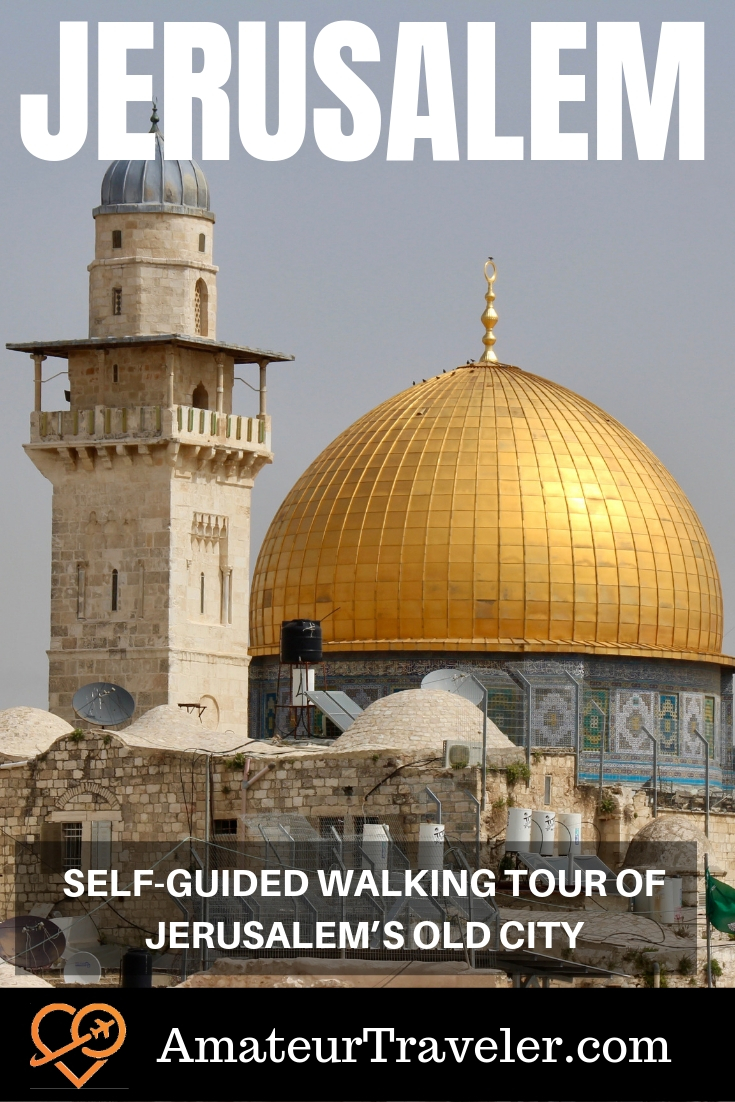
Related Posts
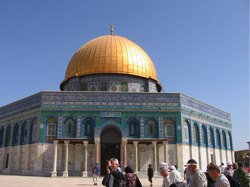
by Chris Christensen
+Chris Christensen | @chris2x | facebook
13 Responses to “Free Self-Guided Walking Tour of Jerusalem’s Old City (with Map)”
Hi Chris, its a learning experience for me reading this article of yours.. Captivated by the images. Thanks
Peter T Sadow
If you are going to post a free walking tour, why not include a path on the map? That would be useful. A google map image of the locations is not useful. You are just being used to advertise a paid walking tour, not a free one.
Sorry, let me see if I can add the path on the map
Sarita Noronha
What time does the walking tour start on Friday?
I don’t know.
it is a pity that you have not visited David’s tower laser show in Jerusalem. Also there is a great park The first station. it’s worth it to come back
piya chakravarty
Show a path that can be used easily by visitors who are mobility challenged instead of having to walk long distances which take you nowhere or to sites you don’t want to visit
Thanks for this great guide! Very helpful!
Chris Christensen
You are most welcome April
You mention much of the Jewish Quarter being destroyed during the Six-Day War. Was not the bulk of the damage at the end of the War of Independnce when Jordan blew up, pillaged, etc. the Jewsih buildings, including the Hurva Synagogue?
I do not know Mike.
Thanks for the great info. Followed your path today and it was great.
Leave a Reply
Name (must be a real name) (required)
Mail (will not be published) (required)
Tags: article , best , day tour , featured , israel , jerusalem , self-guided tour , walking tour

Guides / Resources
- Getting Started Traveling
- Guide to Round The World (RTW) Tickets
- 27 Websites for Booking Hotels and Alternate Accommodations
- First Time Cruise Tips – Planning a Cruise
- How to Start an Airbnb – Tips from an Airbnb Superhost
- Travel Resources – What I Pack
- Map of San Francisco by Neighborhood and What to See by Neighborhood
- Guide to the Monterey Peninsula
- Missions of California Map – All 21 California Missions from South to North

Sign up for our newsletter and get the eBook "How To Save Money Booking Your Travel Online"
World Regions

- BloggerBridge
- California Travel
- Episode Map
- Inside Chris's Head Blog
- My CafePress Store
- My Etsy Store
- The Bible Study Podcast
- Tourism Marketing Consulting
- Privacy Policy
- Amateur Traveler Media Kit
- Working with Amateur Traveler
- Pitch me a Podcast Episode
- Guest Post Guidelines
- Travel with Amateur Traveler group
- The Amateur Traveler Manifesto
- find me on BloggerBridge.com
This website uses cookies to improve your browsing experience and analyze the use of the website. Learn More

Old City of Jerusalem Self-Guided Walking Tour

If you’re interested in learning about the history of Jerusalem through its most notable landmarks, this self-guided tour will help you navigate the streets of this ancient city and see a variety of beautiful and historic sites.
- Jerusalem Map & Overview
- Self-Guided Walking Tour
- Free Jerusalem Walking Tours
- Free Tel Aviv Walking Tours
Self-Guided Old Town Jerusalem Walking Tour
The old town area of Jerusalem is perfect for a self-guided tour, as it includes a variety of historically relevant religious sites, and it’s fairly easy to walk from one point to the next.
That said, you should keep in mind that the entire distance of this tour is approximately 1.75 miles, so while it’s not an especially long walk, you might want to take breaks and prepare to set aside at least 2 hours for the experience.
The Jerusalem map above will provide directions to and from each attraction included on the tour, allowing you to easily find every major historical site in the Old City area.
Our self-guided Jerusalem walking tour begins at the Jaffa Gate, located along the old walls of the city, which will be the first major attraction you’ll see as you walk to the gate.
Along the way, you’ll see sites related to the religious history of Judaism, Islam, and Christianity. We’ll provide information about each attraction to help you learn about the history of Jerusalem in greater detail.
The Jaffa Gate
Walking towards the Jaffa Gate feels like ambling back into another era. The gate has stood firm for centuries, watching countless travelers pass through its arches.

Named after the distant city of Jaffa, it reminds us of when people journeyed from Jaffa, brimming with stories and goods, heading into Jerusalem.
As you gaze upon the gate, the detailed carvings and the grand structure show the craft of artisans from long ago.
The worn paths leading to and from the gate tell sagas of merchants, pilgrims, and wanderers who once made their way through this entrance with hopes and dreams of what lay inside the city.
Beyond the gate, you find yourself surrounded by narrow cobblestone streets. The sound of footsteps echoing, the smell of freshly baked bread from nearby stalls, and the soft hum of voices make the place come alive.
It's easy to lose yourself in the maze of history, imagining the lively markets and the haste of the olden days.
Tower of David
The Tower of David, a silent guardian of Jerusalem's whispers, is far from the Jaffa Gate. Some believe the tower has watched over the city for nearly 2,000 years, silently witnessing its growth and transformation.

Its name is a nod to the city's love and reverence for King David, even though he didn't build it.
The tower has a stoic presence, tall walls, and a magnificent look. Inside, the Tower of David houses a museum like a treasure trove.
Walking through its corridors, you can see artifacts and exhibits showcasing Jerusalem's vibrant past.
From ancient pots to old scrolls, the museum gives you a peek into the lives of people of different ages.
Climbing the tower offers a reward – a sprawling view of Jerusalem. It feels as though the city unfolds before you, showing its secrets and stories.
St. James Cathedral
The musical chimes point to St. James Cathedral, located in the center of the Armenian Quarter. This majestic structure is a beacon of faith for Armenian Christians.
Its tall spires reach for the sky, and its walls are ornamented with intricate art and shimmering gold.
The cathedral was built to honor Saint James, known for his deep faith and teachings about Jesus. Getting inside, the cathedral envelops visitors in peace and reverence.

The beautiful stained glass windows cast colorful patterns on the floor, and the scent of incense fills the air.
Here, you can see faithful individuals lost in prayer and feel the weight of centuries of devotion.
The cathedral, with its art and architecture, stands as a testament to the deep spiritual connection of the Armenian community with Jerusalem.
Walking further, the Zion Gate awaits, with its sturdy walls that have witnessed times of peace and conflict. The bullet marks on the gate are stark reminders of the battles it has seen.

The entrance leads to Mount Zion, making it a significant point of interest for many.
Throughout history, this gate has welcomed Jewish, Christian, and Muslim travelers, each bringing their own stories and traditions.
As you pass through Zion Gate, the ambiance shifts. The stone paths speak of the many feet trodden here, from kings and soldiers to poets and pilgrims.
The walls on either side hold tales of celebrations, ceremonies, and sometimes even sieges.
It's a place where history has unfolded in countless ways, and each stone and corner has its own story.
Mount Zion and King David’s Tomb
A gentle hill called Mount Zion serves as more than just a geographical landmark. It's a tapestry of stories, traditions, and beliefs. Dominating this place is King David's Tomb, a site steeped in reverence.
While some believe it holds the remains of King David, others come here to connect with a past rich with tales of courage, wisdom, and leadership.

Close to the tomb is a room holding monumental significance for Christians. This room is believed to be where Jesus shared his last meal with his disciples.
The walls reflect the conversations and events of that fateful evening. Every building and site in Mount Zion calls for you to stop and take a moment to connect with a time that has passed but was never truly gone.
Hurva Synagogue
Hurva Synagogue, located in the focus of the Jewish Quarter, is an imposing structure that resounds with old stories.
Rebuilt several times after being destroyed, this synagogue is like a phoenix, continually rising from its ashes. Its name, "Hurva," means "ruin," hinting at its tumultuous past.

However, each time it was rebuilt, it came back even grander than before. Today, its fantastic interior and large dome symbolize the Jewish people's tenacity and the resiliency of Jerusalem.
Take in the intricate artwork on its walls and ceilings as you move.
The golden hues and detailed mosaics tell faith, hope, and community anecdotes. The synagogue, now a beacon in the Jewish Quarter, represents perseverance.
It stands as a reminder that even in tough times, the spirit of the community and their faith remains unshaken.
Western Wall
You'll find the Western Wall a few steps from the Hurva Synagogue. It's a massive limestone wall and is the last remnant of the Second Temple.
Many people come here, notes in hand, to place their written prayers into the wall's cracks.

This place has heard the whispers and cries of countless souls, each pouring their heart out in prayer.
People of all backgrounds have stood before this ancient wall for centuries, feeling its excellent, rugged surface beneath their fingertips.
The wall has seen times of joy and sorrow and remains a symbol of hope and faith for many. As you stand there, take a moment to feel the energy and history that resonates from its stones.
Al-Aqsa Mosque
The Al-Aqsa Mosque is invited with its vast courtyard and unique dome. Known as one of the holiest sites in Islam, it has welcomed worshippers for over a thousand years.
The mosque, with its silver dome and elegant minarets, is an architectural gem that reflects the richness of Islamic art and culture.

The mosque is embellished with detailed designs, conveying stories of devotion and faith. The soft carpets, the shimmering lights, and the serene ambiance make it a haven of peace.
For many, a visit to Al-Aqsa is a journey of spiritual renewal, a chance to connect deeper with their faith.
Dome of the Rock and Temple Mount

Nearby stands the Dome of the Rock, easily recognizable with its golden dome shining under the sun.
Sitting atop the Temple Mount, this site is significant for Jews and Muslims. For Muslims, it's believed to be the spot where Prophet Muhammad ascended to heaven.
For Jews, it's the place where Abraham prepared to sacrifice his son. The exterior, ornamented with beautiful tiles and inscriptions, is a treat for the eyes.
The surrounding area, Temple Mount, offers panoramic views of Jerusalem. History and faith intertwine here, making it a melting pot of faith and beliefs.
Via Dolorosa
Via Dolorosa, or the "Way of Sorrow," is a winding path filled with stories of sacrifice and passion.

It's believed to be the route Jesus took, carrying his cross, on the way to his crucifixion.
As you tread this path, you'll discover several stations marking significant events from Jesus' final journey.
The cobblestone streets, the ancient arches, and the murmur of prayers create a reflective atmosphere.
Many pilgrims walk this path, retracing the steps of Jesus, with hearts full of gratitude and reverence.
Church of the Holy Sepulchre
A stone's throw from Via Dolorosa, the Church of the Holy Sepulchre is a significant Christian site.
It's believed to house the tomb where Jesus was buried and resurrected. With its grand entrance and ornate design, the church has seen pilgrims worldwide, each coming to connect with their faith.

Inside, the soft glow of candles, the scent of incense, and the peaceful prayers make for a soulful experience.
With its mosaics and relics, the church is like a living museum of Christian history and devotion.
As your journey winds down, the New Gate awaits. It's the newest entrance to the Old City, but even this "new" gate is steeped in history.

Built in the late 1800s, it was a passageway for Christian pilgrims wanting to visit the Holy Sepulchre.
The gate, with its arched entrance and sturdy design, has seen the footsteps of countless pilgrims and travelers.
You'll feel a mix of the old and new while moving across the New Gate.
The walls around the gate, marked with time, stand as witnesses to the ever-evolving story of Jerusalem.
It's a fitting conclusion to a journey through the foundation of this ancient city.
Choose a Destination... I want them all PLUS general travel tips. Amsterdam Berlin Boston Charleston Chicago Dubai Lisbon London Los Angeles Miami Nashville New York City New Orleans Paris Philadelphia Prague Rome San Francisco Washington DC
About The Author

North America
United kingdom & ireland, middle east & india, asia & oceania.

Before you go, check this out!
We have lots more on the site to show you. You've only seen one page. Check out this post which is one of the most popular of all time.
How to tour Jerusalem on your own: a step-by-step guide
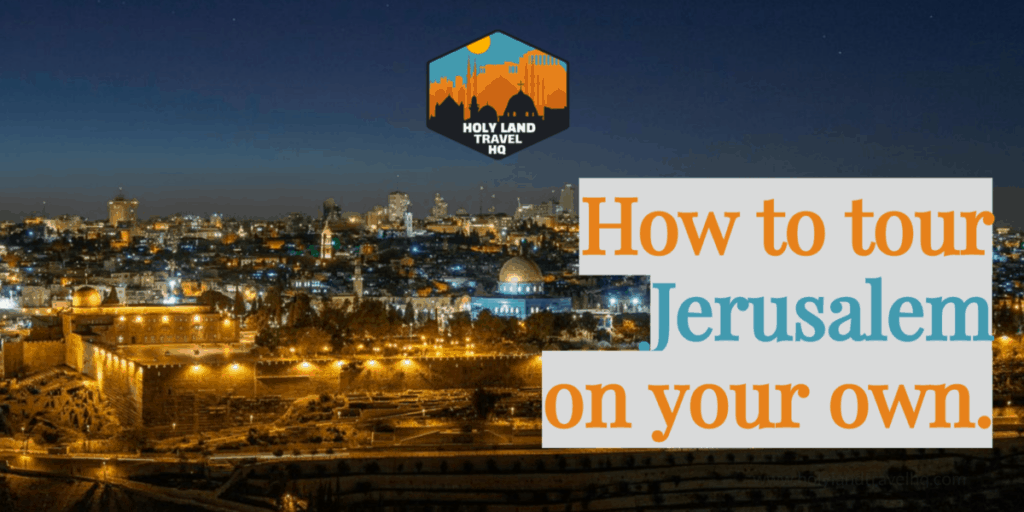
For some of you, a tour package or church group might not be the right fit. Maybe your schedule doesn’t match up. Or you suddenly get sent on a business trip to Israel and you want to take advantage of the opportunity. And then there are those who just want to go it alone.
If any of these situations sound like you, then you’re in the right place.
Here is what you need to know to tour Jerusalem on your own. I’ll cover the rest of Israel in another post, but today let’s get into the City of Peace.
I’ll start off with the logistics of your travel, which encompasses:
- Getting to Jerusalem
- Getting around town
Is it safe to walk around Jerusalem?
- Accommodations
Do you need a tour guide for Jerusalem?
And then I’ll finish with an extensive itinerary (WITH MAPS). This list is not exhaustive, but it will give you a good deep dive into what is there to see.
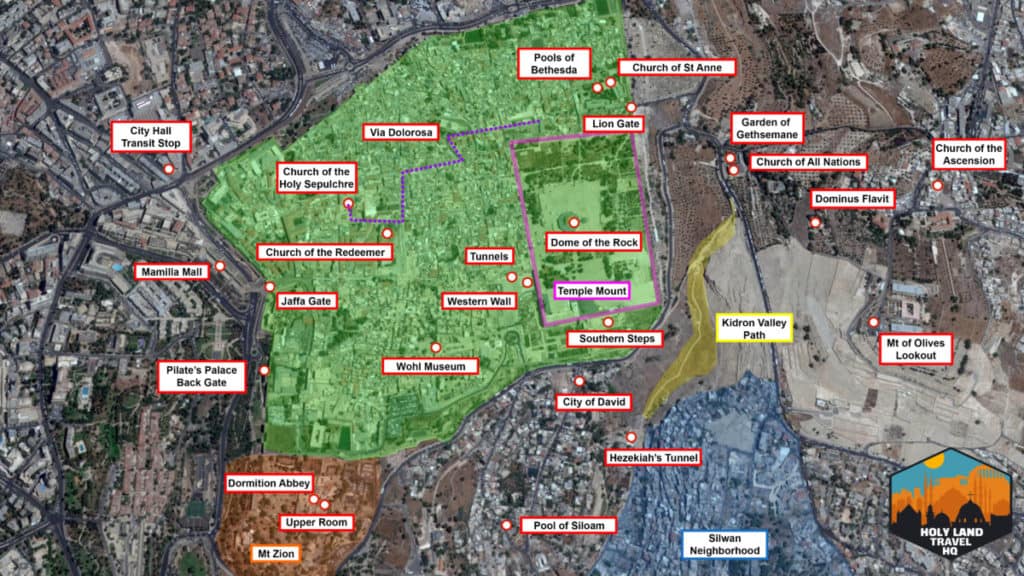
- Mount of Olives Lookout
- Church of the Ascension
- Dominus Flavit
- Church of All Nations & Garden of Gethsemane
- Kidron Valley
- The Garden Tomb – If time permits. 2/3 mile walk from St Anne’s.
- Church of St. Anne
- Bethesda Pools
- Western Wall
- The Southern Steps
- Temple Mount
- Via Dolorosa
- Church of the Holy Sepulcher
- Old City Market
- Israel Museum
- Holocaust Museum (Yad Vashem)
- Western Wall Tunnels – Must schedule a time. Recommend Evening.
- City of David
- Hezekiah’s Tunnel
- Pool of Siloam
- Wohl Museum Mount Zion (House of Caiaphas)
- The Upper Room
Note: All links are direct. All Bible verses link to biblegateway.com .
Getting to Jerusalem.
There are a few ways to get to Jerusalem if you are not already there. The first is public transportation. The main bus company is called Egged . They have a direct route from Tel Aviv Central Bus station to the Jerusalem Central Bus Station. It takes about an hour and costs around $5 USD.
The Jerusalem Central Bus Station is about a 2-mile walk to the Old City.
Egged has routes all over the country. For more information check out their website right here .
If you’re in Tel Aviv, want to be dropped off at the Old City, and don’t mind sharing a ride; get a Nesher Sherut . It’s a shared ride, like a Super Shuttle but a little roomier.
A Sherut is an airporter that departs from and goes to Ben Gurion Airport. It costs around $17 USD. The advantage is that it can drop you off anywhere in Jerusalem that you want. I recommend Jaffa gate, which is the Old City.
The downside is that you can only get them unscheduled from the Airport. You have to schedule a pickup for the trip back to the airport.
A taxi is the most convenient, but also the costliest. From Tel Aviv, it will run you between $60 and $80 USD.
Rental cars are also an option. Most of the major rental companies are in Israel. Avis . Budget . Hertz . (links are direct). The problem with renting is cost and parking. This is why a taxi is the most convenient.
Uber is present in Israel, but only in Tel Aviv. And regulations only allow cabs to offer the service.
Getting around town.
Once you arrive in Jerusalem, most of the sites on the itinerary below are in and around the Old City. You can draw a circle with a 3/4-mile radius and hit all but 3 of the sites on the list.
Whether you take a regular tour or do it on your own, Jerusalem’s Old City is done on foot . There is no way around it.
The Yehuda Market is about a mile up Jaffa street from Jaffa Gate. Jerusalem has a light rail system that you can catch if you want to take a break from walking. The closest stop is at City Hall, which is across the street from the northwest corner of the Old City.
The light rail only has one line. The Yad Vashem Holocaust Museum is at the southwest end of that line.
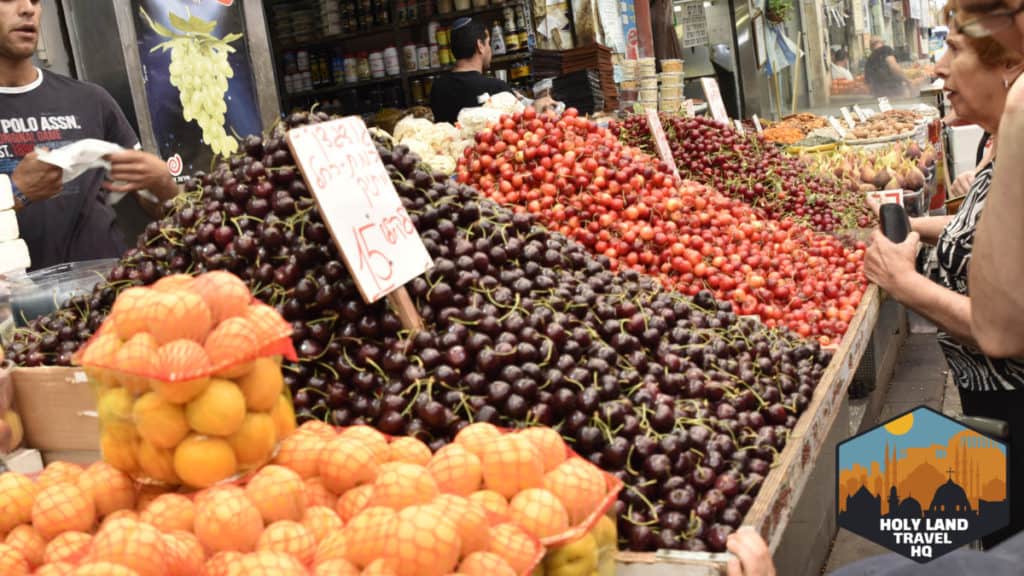
So, a good idea is to board the light rail in the morning at the City Hall stop. Take the line towards the Yehuda Market, but don’t get off. Keep going until you reach the Mount Herzl stop. Visit the Museum. Then catch the light rail back to the Old City, getting off at the Yehuda Market for lunch.
For information on Jerusalem’s bus and light rail system visit the Citypass website right here .
The Israel Museum is just under 2 miles from Jaffa gate. If you feel like walking it, feel free to do so. There are sidewalks the entirety of the route. If you don’t want to walk, you can get there by bus or taxi . The light rail does not have a stop there.
If you’ve ever rented a Lime or Bird electric scooter or bike you are in luck. Both companies are launching limited services in Jerusalem.
Despite the impression the news portrays about Israel, Jerusalem is a very safe city. It’s probably one of the safest cities I’ve ever been to.
For a full discussion on safety in Israel, check out my post on the topic right here .
As I discuss in that post, the primary threat you will encounter is petty crime such as pickpocketing and swindling. And the majority of that is confined to the Old City and other crowded areas.
If you are walking to the Israel Museum or around town, your biggest threat is vehicle traffic. So, stay on the sidewalk and pay attention to lights and signs.
Like any city, though, Jerusalem does have its problem neighborhoods. Two areas you want to steer shy of are the Kidron Valley at night and the Silwan neighborhood.
The Silwan neighborhood occupies the southeast slope of the Kidron Valley. It’s not like southcentral LA, but it is on the soft end of that spectrum. Crime ranges from vandalism on up to clashes with police.
The conflict is primarily between the Palestinian inhabitants of Silwan and orthodox Jews who are trying to claim the land.
The Kidron Valley during the daytime is not a problem, but stay away at night time. Its steep slopes create a funnel for pedestrians on the walking path. This invites nefarious activity such as mugging.
Accommodations.
If you have more than one day, you’re going to need a place to stay. There are a couple of options. Prices vary depending on the time of year.
The first option is to stay in a hostel. If you’ve never stayed in one before, a hostel can be quite the experience.
Hostels are generally geared towards young solo travelers who want to meet new people. However, all ages are welcome, and so are groups.
Amenities can vary as well. For example, Capsuleinn has enclosed bunks with lights, electrical outlets, TV screens, and air vents. Other hostels are merely bunk rooms.
Some hostels have kitchens. And some offer nightlife and social activities.
To book, check prices, and find availability of hostels in Jerusalem, check out this filtered search at Booking.com .
The second option is a hotel. Rooms run the gamut on price. Everyone is or should be familiar with how to get a hotel room. Hotels in Jerusalem are no different than hotels in the United States or Europe.
To book, check prices, and find availability of hotels in Jerusalem, check out this filtered search at Booking.com . Or check your favorite travel site.
Air BnB is the third option. If you aren’t familiar with the latest craze in lodging, Air BnB is an online hospitality marketplace. For the most part, listings are often for full houses, apartments, or condos. But sometimes people will list rooms or granny flats.
All listings are facilitated by Air BnB but listed by the property owner.
For owners listing their properties, Air BnB is essentially a small business. As a result, customer service and amenities vary greatly.
Air BnB is basically like having your own apartment in the city for a couple of days. And you won’t get bothered by maid service.
If you get a good tour book and plan ahead, you don’t need a guide. But the advantage of getting a tour guide is their experience with the territory and a streamlined itinerary.
Note: Because I have not done one of these day tours in Jerusalem yet, most of my advice here will defer to an expert. After much research, I found a website named travelingisreal.com . The site is run by Oren, who is a tour guide living in Israel.
Tour guide options are plentiful. Like the guidance I gave in my post about group-tour costs , there are 3 monetary levels of day-tours. However, unlike my guidance there, which recommended the midlevel group-tours, here I’m going to advise you to stay away from the midlevel day-tours. Seek out the cheap tours or tailored tours.
Oren points out that the midlevel tours are typically designed to pick you up at your hotel. Whether it’s from Tel Aviv or Jerusalem, much time is wasted on picking everyone up. Time is also wasted on shopping.
The cheap day-tours are short and to the point. They leave from a common meeting spot and last only a couple of hours.
The luxury, or tailored individual tours, are focused. And shopping is up to you. Oren’s company facilitates these types of tours. For more information check out Shin Luxury Tours . On average a luxury tour will cost you around $200-$300 USD a day.
The two cheap level tour companies Oren recommends are Abraham Tours and the free tour at Sandeman’s New Europe Tours . The free tour is free, but not really. The guide doesn’t get paid for it, which is why it’s advertised as a tip-based tour. On average, the day tours with Abraham and Sandeman range between $20 and $60 USD.
What you will miss on a self-guided tour.
Visiting the Holy Land is a unique experience. So much has happened there throughout history. As a Christian, the sites will make your understanding of the events in the Bible more real.
A self-guided tour, or even one of the day tours discussed above, can show you these sites. But you might miss out on the backstories and biblical significance of certain spots.
I don’t know the theological bent of any of the day tours I mentioned above. Or of any tour books, you may be inclined to buy. Without a good tour leader and tour guide, you may end up merely sightseeing through one of the most fascinating, historic locations in the world.
As a Christian, the theological bent of your trip is something you should place high on your list. Oren comes across as a genuine guy, which is why I chose to mention him. However, I do not know him in order to give a full recommendation.
If you do any research, make theology a top priority. You will thank yourself.
Sites to see
Day 1 – walking the old city..
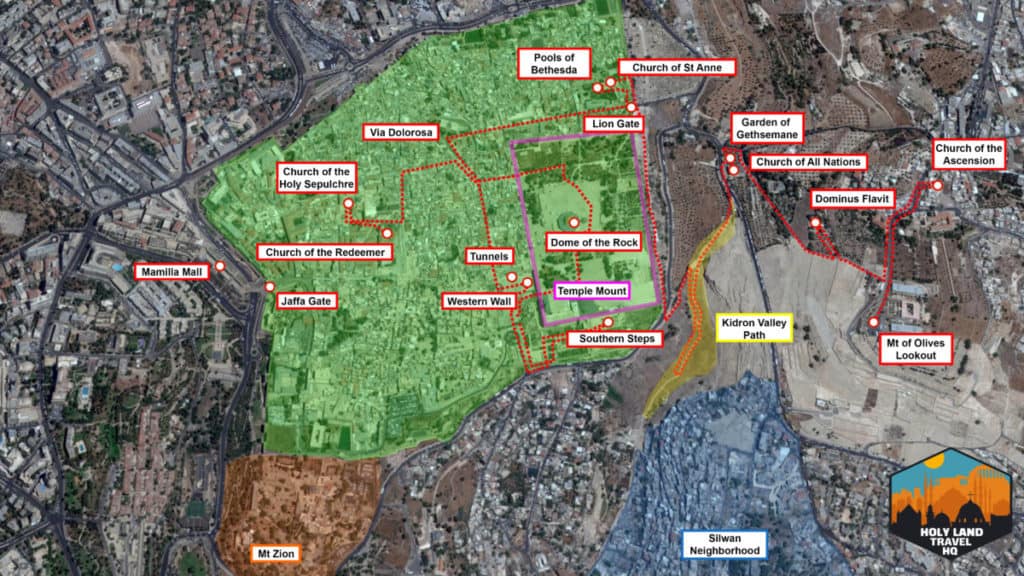
Mount of Olives Lookout – There is nothing significant about the spot, other than it provides a great view of the Old City. Groups start showing up around 7:30 or 8 am. I normally get up early to arrive by 6 or 6:30 am. The breeze across the mount and the rising sun provides a great atmosphere for a daily devotional. Or just some alone time with God. It’s also a great place to start the tour for the day.
Church of the Ascension – this is the traditional spot where Jesus ascended into Heaven after his resurrection. Something interesting about it is that it has the signature Byzantine-era octagonal shape, like the Dome of the Rock. It’s actually a mosque, but open to anyone willing to pay a fee.
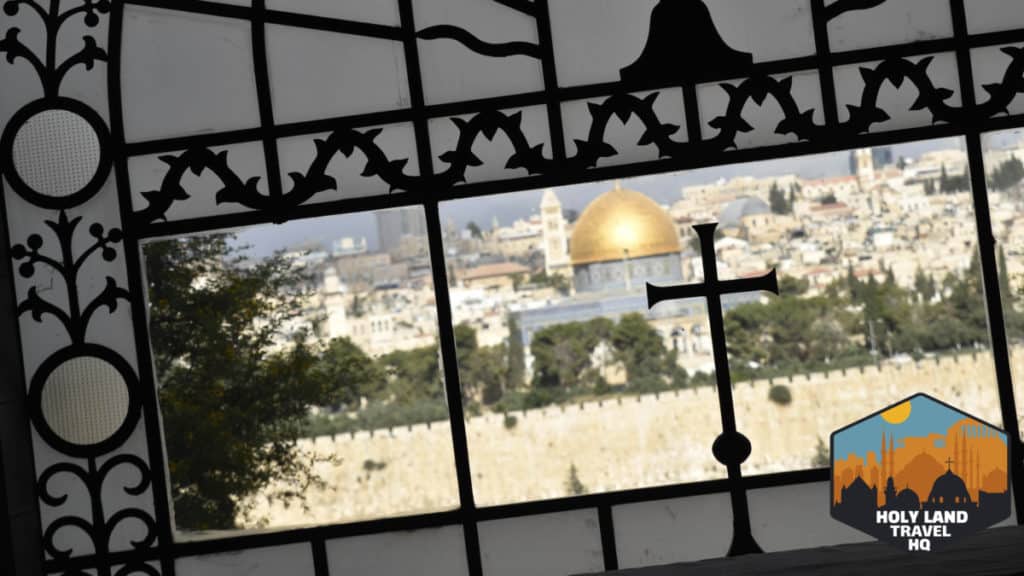
Dominus Flavit – The chapel was built in 1955 by the Roman Catholic Church. It commemorates the spot where Jesus wept. On the property is an ancient Canaanite necropolis where bodies were laid to decompose. Several sarcophagi are inside, some of which are shattered due to looting. A body in a necropolis took about a year to fully decompose. Only the bones remained and they were placed in a small box called a sarcophagus.
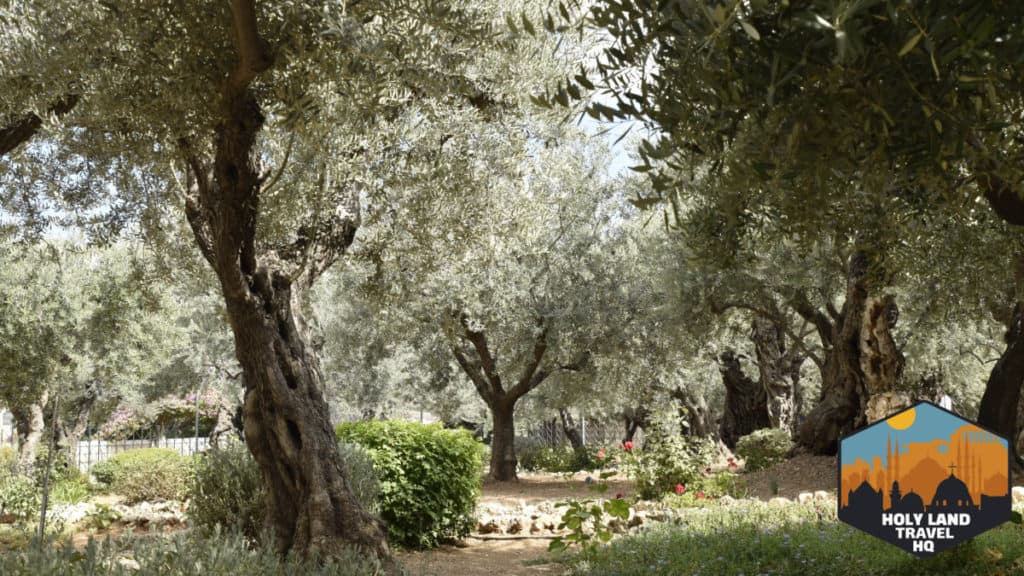
Church of All Nations (Garden of Gethsemane) – The church was built by the Roman Catholic Church and opened in 1924. Its main draw is the olive tree garden which is the traditional location for the Garden of Gethsemane.
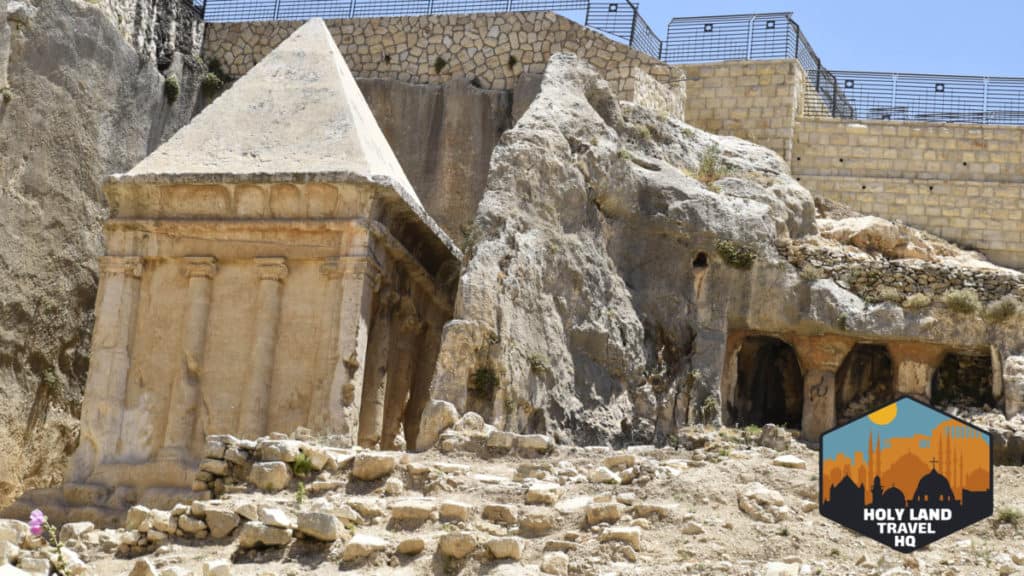
Kidron Valley – Along the walking path of the Kidron valley are a few things to see, including Absalom’s tomb. There’s a ramp that goes up to the Old City and the City of David archaeological dig. If you follow the valley down, it will meet with the Hinnom valley. Many tourists are underwhelmed by the size of the valley.
The Garden Tomb – To the north of the Old City sits a garden with a 1 st century tomb in it. It’s highly unlikely this is the tomb of Jesus. What makes it interesting is the circular stone that sits at the entrance. It’s more of an example of what the tomb of Jesus looked like. This hasn’t stopped the site from being a draw for visiting Christians. There are areas for groups to gather and worship at the site. It has a rather serene atmosphere to it.
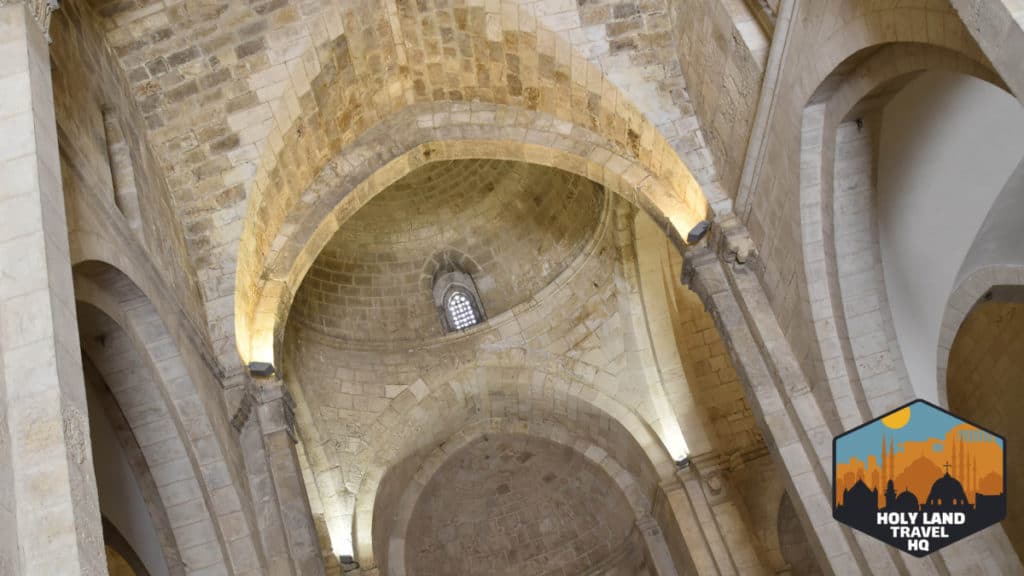
Church of St. Anne – The church was built in the 1130s CE during the crusades. It replaced a Byzantine basilica which replaced a Roman-era pagan shrine before it. Tradition holds that the childhood home of Mary, the mother of Jesus, was located on the spot. The church is known for its acoustics and is often a great place for tour guides to stop for a theological moment.
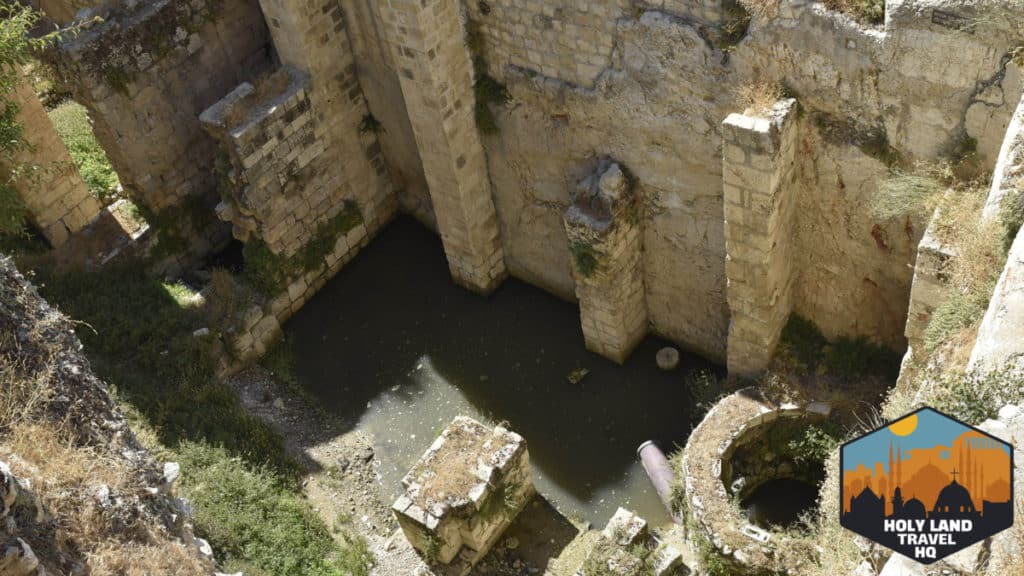
Bethesda Pools – John 5 tells the story of Jesus healing a crippled man at the pools of Bethesda near the Sheep gate. Also called the Lion Gate. In the 19 th century, Archaeologists discovered a portion of the support structure for and colonnades for the pools. The fact that something described in the Bible was found exactly where the Bible said it was, makes the Pools of Bethesda fascinating.
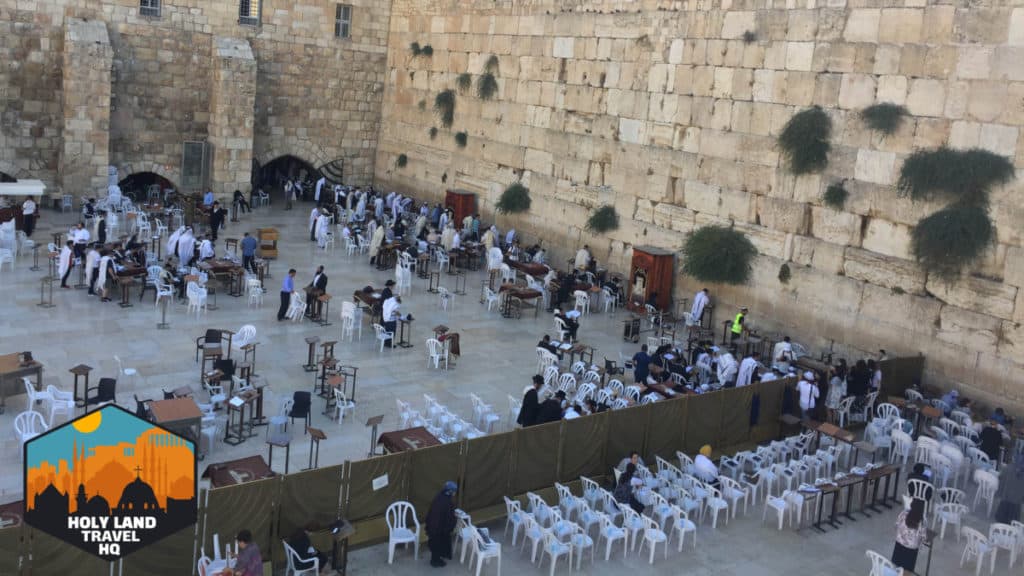
Western Wall – This is the site most associated with Jerusalem. The site is designated an active outdoor synagogue, which is why there is so much religious activity there on a daily basis. It’s not just an archaeological site. The wall itself is only a small portion of the larger west retaining wall of the Temple Mount.
The Western Wall doesn’t have any direct significance in the biblical narrative. However, it represents the significance of the Second Hebrew Temple which was a centerpiece in the Gospels. For more info on the Western Wall, check out my post on the site right here .
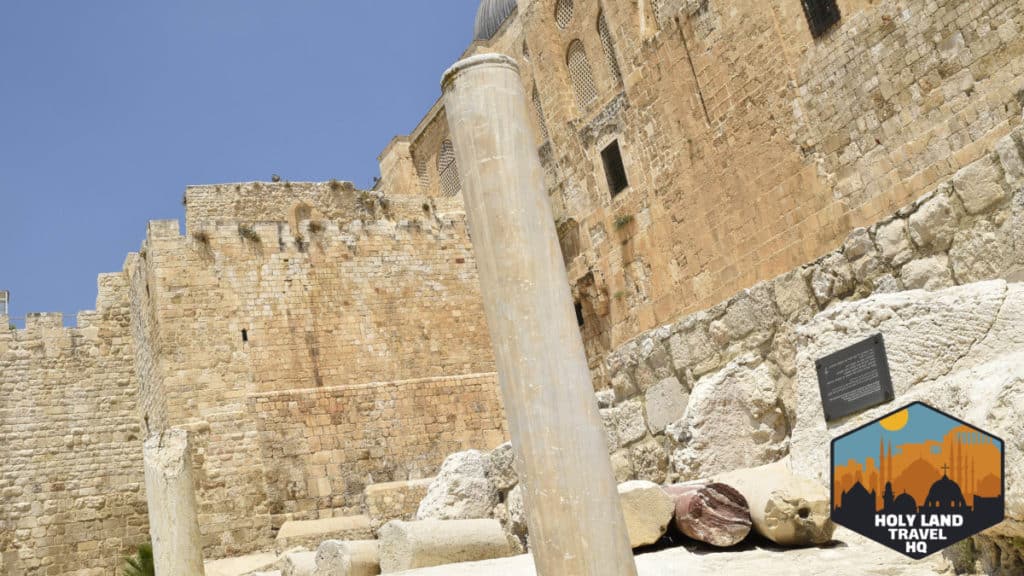
The Southern Steps – On the south end of the Temple Mount are the Southern Steps, which lead to the Double and Triple gates. The commoner would have used these steps to enter the temple for Passover , Shavuot , and Sukkot . This means that Mary and Joseph would have climbed these steps when they presented Jesus at the Temple ( Luke 2:22 ). Jesus most likely climbed the same steps later in Luke 2 as a child. And then again in John 8 when he taught in the temple courts. The idea here isn’t that the Southern Steps are holy ground. Instead, they give us a picture of the 1 st century and the world where Jesus walked.
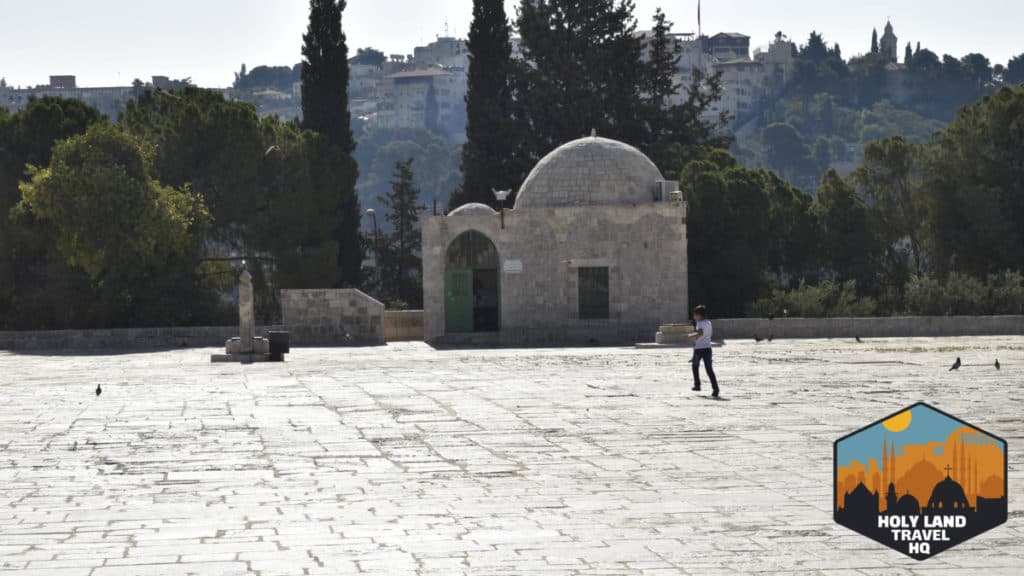
Temple Mount – This is the large stone-walled structure in which the Second Hebrew temple was built upon. Today it supports the Dome of the Rock and the Al Aqsa Mosque. Muslims call it the Haram al-Sharif or the “Noble Sanctuary.” The platform is approximately 37 acres . For more information on the Temple Mount check out my post on the Dome of the Rock right here . The entrance is next to the Western Wall. The exit will spit you out near the Via Dolorosa.
Via Dolorosa – This isn’t much of a site or even a series of sites. The Via Dolorosa is a street that tradition says was the path Jesus carried His cross on the way to Calvary. There are 15 stations of the cross. The first station is where Jesus stood trial in the Antonia Fortress. The actual location is near the Lions Gate. The path ends at the Church of the Holy Sepulchre, where Jesus was placed in the tomb.
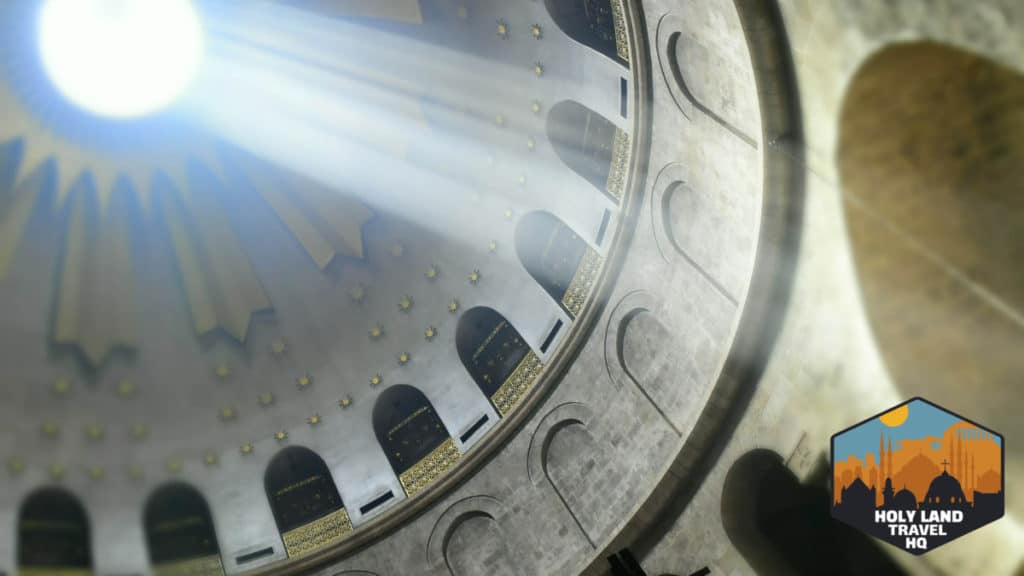
Church of the Holy Sepulcher – Finished in 325 CE, the church was built on the spot considered by tradition to be the tomb of Jesus. The earth around the tomb had been removed and the structure known as the Anastasis Rotunda was built around it. After converting to Christianity, Constantine sent his mother, Helena, to Jerusalem to find the tomb. The church has been a Christian pilgrimage site for almost 2,000 years. For modern crowds, it tends to be the most surprising site with its bevy of gaudy Medieval iconography and strange denominational territorialism.
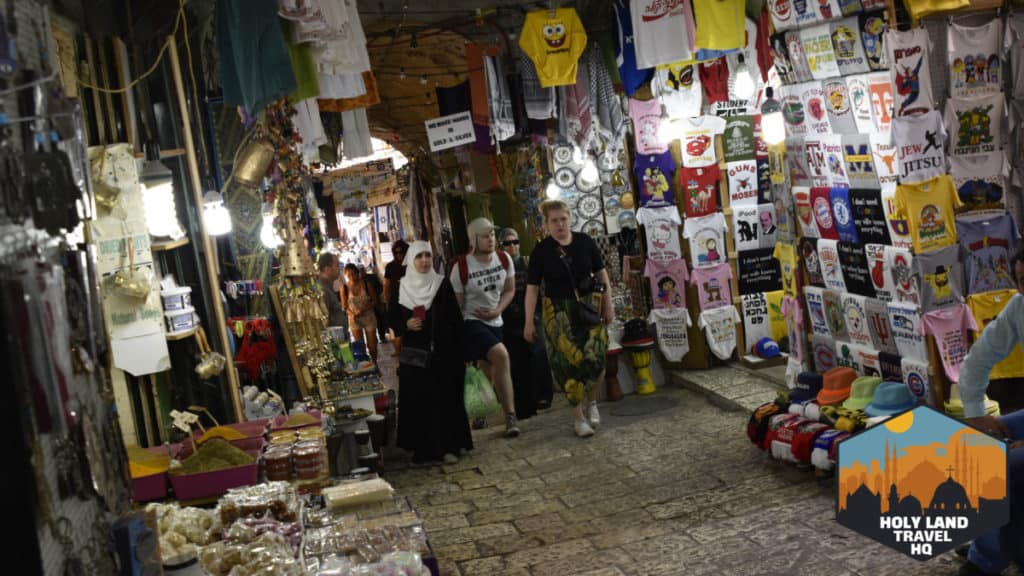
Old City Market – Surprise! You’re already in the market. The Old City is pretty much a big market. Some of the paving stones in the Old City Market are old. Possibly from the 1 st century. The market was not around in the 1 st century though. This doesn’t mean it’s not interesting or worth the adventure. The main thing you’ll find here though is souvenir shopping.
If you have it, Day 2 – The Museums
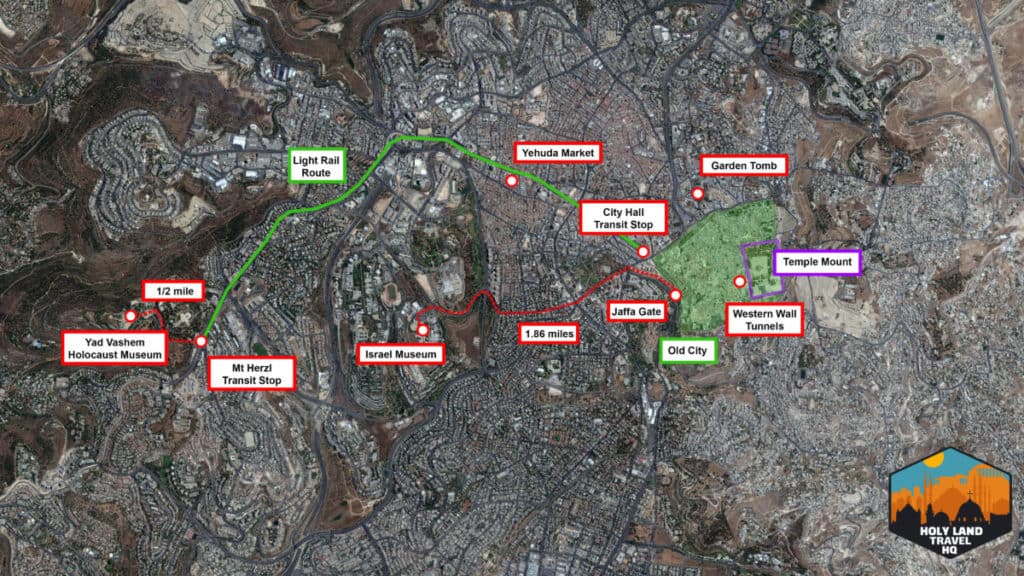
Israel Museum – The museum is home to thousands of finds throughout Israel. The exhibits span the full range of biblical and world history. The most notable exhibit is a full scroll of Isaiah found in the Qumran caves. In the last few years, it has been taken down and replaced with a full picture. It’s quite anti-climactic.
Holocaust Museum (Yad Vashem) – the Jewish Holocaust is a significant event in not only Jewish history but world history. Much like the Holocaust museum in Washington DC, this one is just as good.
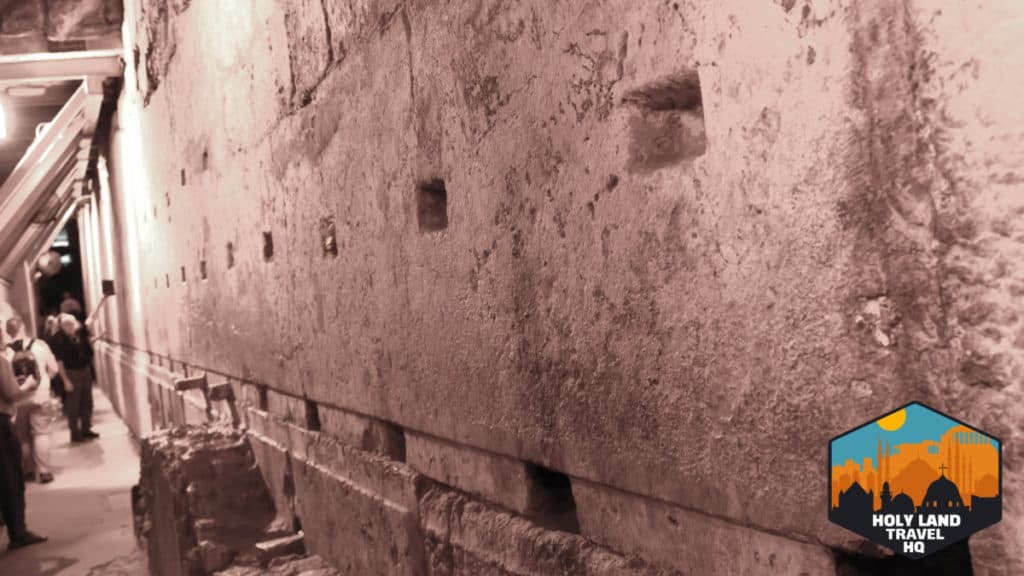
Western Wall Tunnels – the tunnels were discovered in the mid-18 th century by British archaeologist Charles Wilson. Excavations since then have revealed the original 1 st century sidewalk as well as some very large foundation stones. Tours of the tunnel are offered daily. They provide insight into the construction of the Temple Mount and what the city-scape looked like in the 1 st century. For more information on the tunnels check out my post on the Western Wall .
If you get a three-day weekend, Day 3 –City of David and Mount Zion
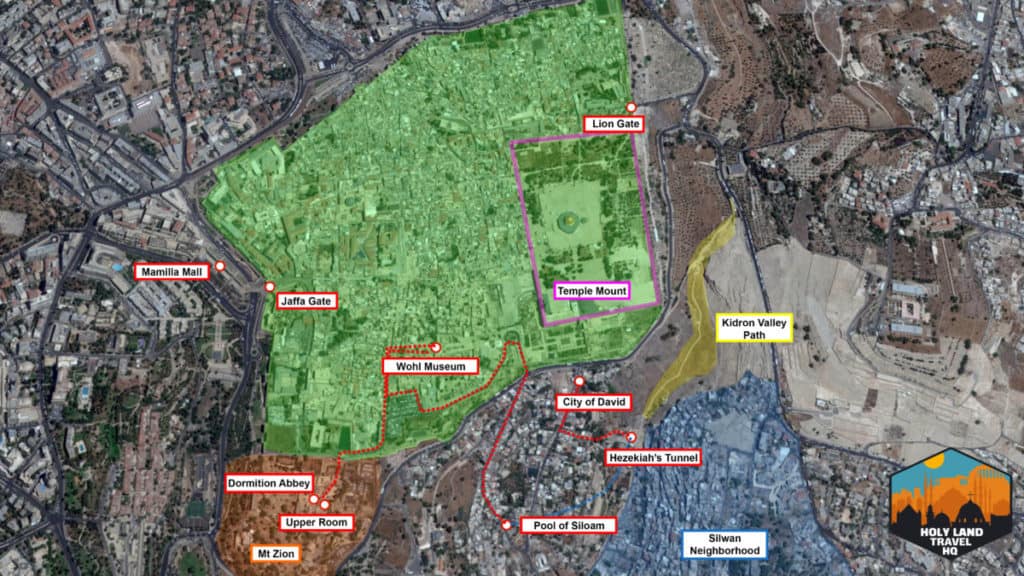
City of David – Over the past several decades, archaeologists have been uncovering the spot where the original city was located. During the time of David. Nehemiah’s wall has been discovered, as well as Hezekiah’s tunnel.
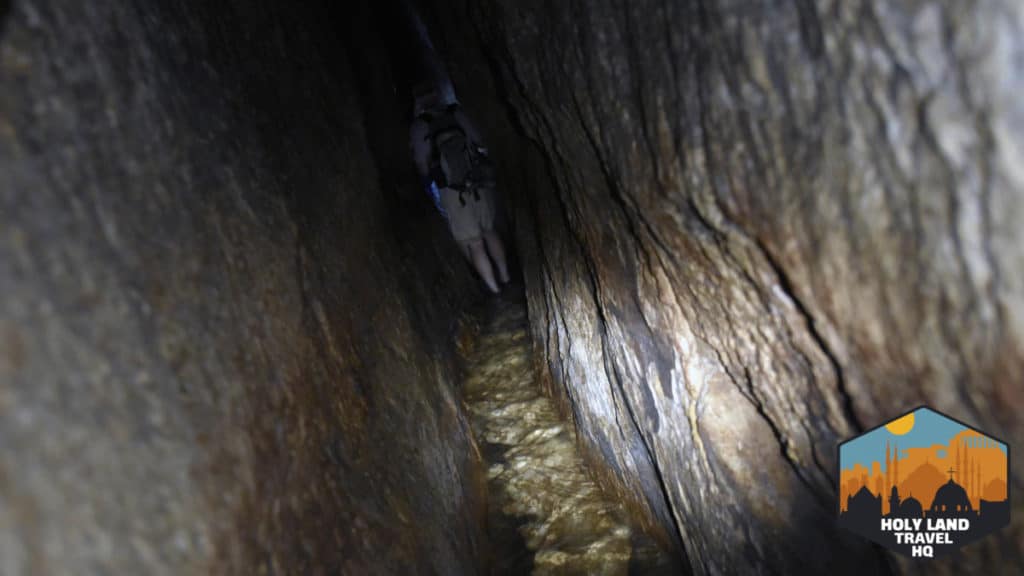
Hezekiah’s Tunnel – The tunnel was dug at the direction of Hezekiah prior to the Assyrian siege discussed in 2 Chronicles 32 . The tunnel leads from the Gihon spring, which is outside the city wall, to the pool of Siloam, inside the city wall. It’s a fascinating trek as you get to walk through the entirety of the tunnel.

The Pool of Siloam – the tour of Hezekiah’s tunnel spits out at the Pool of Siloam. It’s nasty looking, but interesting because of it’s place in the Bible.

Wohl Museum Mount Zion (House of Caiaphas) – This is a museum in the Jewish quarter. It’s a site in which archaeologists believe to be the house of Caiaphas. If you remember, Caiaphas was the priest in the Gospels who opposed Jesus. The site gives visitors a glimpse into priestly living in the 1 st century. As well as life in the 1 st century in general.
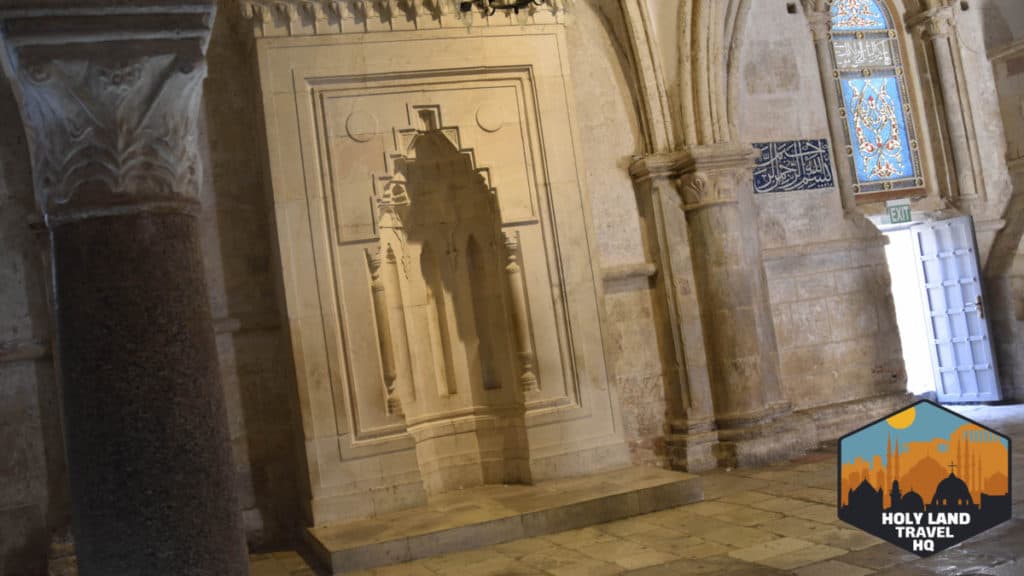
The Upper Room – Located inside the compound where David’s Tomb is located on Mount Zion. The upper room is the traditional location for the Last Supper. It has been spruced up and renovated over the last 2,000 years, so it hardly looks like a room from the 1 st century. It’s possible the Last Supper occurred at the spot, and it’s just been hideously transformed. It’s more likely the original structure was destroyed and a new one erected. Or it’s largely symbolic and the location is just a hypothesis. Either way, it’s a Christian tradition.
Recent Posts
What is the Via Dolorosa?
Every year, millions of Christians make the pilgrimage to the Holy Land to walk in the footsteps of Jesus. One of the many attractions they will experience is the Via Dolorosa. Or The Way of the...
How to Rent a Car in Israel and The West Bank
One of the questions I get asked the most is how to rent a car in Israel. But more specifically, can you take that rental car into the West Bank.


- WHERE TO GO
- WHERE TO STAY
- EPIC HOTELS
- DIY HOLIDAY ITINERARIES
- WORLDSCHOOLING
- MALAYSIA ITINERARIES
- THAILAND ITINERARIES
- BALI ITINERARIES
- CAMBODIA ITINERARIES
- VIETNAM ITINERARIES
- ISRAEL ITINERARIES
- JORDAN ITINERARIES
- FAMILY FRIENDLY HOTELS
- FLYING WITH KIDS
- BUDGET TRAVEL TIPS
- BEST TRAVEL GEAR
- BUDGET HOTELS
- LUXURY HOTELS
- VILLAS WITH PRIVATE POOLS
ISRAEL , START HERE | , TRAVEL DESTINATIONS | , WHERE TO GO
Jerusalem walking tour – self-guided old city tour 2024.

Table of Contents
In this article, we are going to share an independent, self-guided Jerusalem walking tour for 2024. The aim of this walking tour is to help you see all of the best attractions around the old city. We have designed a route that maximises attractions and sights but minimises your distance.
Important: There are a few challenges walking around Jerusalem – so please do read this article carefully.
We absolutely loved exploring Jeursalem and we have designed this walking tour to help share our highlights. This saying is so true “If we can do it, so can you”. And we want to show you how to do it step-by-step.
We have tried to make this walking tour as helpful as possible, including a map, a route, and fascinating things that you can see along the way.
Looking for an amazing place to stay? Check out these dreamy luxury hotels in Jerusalem
Looking for more inspo? Don’t miss these Amazing things to do in Jerusalem
This walking tour aims to hit all of the “big must-see” attractions – so that you don’t miss any of the BEST bits. We have included an optional detour up the mount of Olives (you may want to time this with sunset). We have also included the route of the Via Dolorosa. As a self-guided tour you will need to navigate yourself. Take a print screen of our map or get some data on the go so that you can navigate (remember to enable GPS location on your phone to help you navigate).
Staying for a few days? Don’t miss our in depth 3 day Jerusalem Itinerary
Map of a free Jerusalem old city walking tour
Summary of this Jerusalem walking tour
How far is this walking tour.
It is worth recognizing that this is a pretty long walking tour, and there are some uphill sections, especially from the City of David back to the Jerusalem old city, and also up the Mount of Olives. An average person may find this walking tour quite challenging for one day.
Total distance (excluding the Mount of Olives) : 4.7 km
Total distance (including the Mount of Olives) : 5.9 km
Approximate time : 4 – 6 hours (depending on stops)
Here are some ways that you can make this walking tour a little bit easier. We especially recommend this if you’re planning to do the walking tour with young kids. Firstly, some sections can be done by bus or taxi. When we share our full and in-depth description of the route, we will also indicate which sections might be done by bus or taxi. Another way to make this walking tour more approachable is to divide it into two separate days. This is a great idea if you have a little longer in Jerusalem (a 2-3 km loop on each day).
Why take a Jerusalem walking tour?

If you’re planning to explore Jerusalem, then we highly recommend taking a Jerusalem walking tour, whether you follow the route that we have suggested in this article or book yourself onto a guided tour . Taking a Jerusalem walking tour is a perfect way to see, smell, feel, and experience this unique and rich ancient city. Taking a Jerusalem walking tour allows you to see things that you may miss if you were to zip around in a taxi. What’s more, there are many parts of the Jerusalem old city which are inaccessible to cars, taxis, and bikes. Therefore, much of the old city, the only way to explore is to take a walking tour. We really enjoyed walking around the Jerusalem Old City. It is genuinely a multi-sensory experience with markets, food stalls, spice shops, and plenty of locals trying to sell you everything under the sun.
Is it better to do an independent walking tour or to pay for a guided tour?
Whether you prefer to take an independent self-guided tour or pay for a guided tour is a matter of personal preference. There are advantages to each and disadvantages to each. Personally, we love exploring new places on our own and at our own pace. However, being part of a guided tour can be a lot of fun. You don’t need to worry about navigation or getting lost, and you can just listen to your tour guide explaining and discussing the fascinating history of the places that you are exploring.
Here is a summary of the advantages and disadvantages of each type of walking tour:
Top tips if you are doing a Jerusalem walking tour

Here are a few top tips and ideas to help you make the most of a Jerusalem walking tour:
1 Wear good shoes
Firstly, we recommend that you wear a good pair of shoes. There is a lot of walking, which includes some uphill sections, and having a comfortable pair of walking shoes is highly recommended. The best type of shoes for exploring the Jerusalem Old City would be a pair of trainers. Ensure you wear comfortable socks too. This will help prevent rubbing or blisters.
2 Bring sun protection
Much of the Jerusalem old city is actually in shade and pretty cool throughout the day. However, there are some sections of this Jerusalem walking tour which are relatively exposed. If you hit these sections during the heat of the day, we recommend considering sun protection. We have found a small umbrella is an ideal way to keep ourselves and our kids covered from the Sun. However, you may also consider sun hats. We also recommend wearing a high Factor Sun cream, especially if you’re planning to explore Jerusalem during the summer months of July and August.
3 Bring a water bottle
We strongly recommend that you bring a water bottle on your Jerusalem walking tour. There are shops throughout this route selling water, and in some places, you can find water fountains, so you can top up a water bottle. The hot, dry Jerusalem climate can be very dehydrating, so make sure you always have some water in your bag.
4 Don’t feel like you need to stop for every conversation
The local culture in Jerusalem is very friendly and welcoming. As you walk around the Jerusalem Old City, you will find that locals will want to start conversations with you, find out where you are from, and have a general chat. In many cases, they are trying to get you to come into their shop or sell you something. We have found the best way to respond to this is to be polite and friendly but keep moving. Just because someone is starting a conversation with you doesn’t mean that you need to stop, and it certainly doesn’t mean that you need to buy something. The locals in Jerusalem won’t be offended if you smile and keep moving.
5 Barter for a fair price
If you’re planning to buy anything from the market stalls, especially gifts or clothing, then we highly recommend that you barter to get a fair price. Remember that you can often find the same products at many different stores, so if you’re not happy with the price, then just keep looking. We have found the most effective way to barter is to be positive and friendly, build a rapport with someone, but not feel like you need to buy it if you are unhappy with the price.
Jerusalem Walking Tour – In-Depth Guide
You can start this Jerusalem walking tour at any point on the map. However, for convenience, we have decided to start at the Damascus gate since there is a lot of accommodation here. You’re likely to get dropped off at this location if you’re traveling to the Old City from other locations in Jerusalem.
1 The Damascus Gate

The Damascus gate is a beautiful bustling Old City Gate situated on the north wall of the old city. There are plenty of Market stalls in this area, and local food is available. Also, there are also a couple of bus stations around here, and this is a great place to grab a taxi. There is also some great accommodation in the Damascus gate area. In our opinion, the Damascus gate is a wonderful place to start your walking tour in the morning. This area has a lovely tranquil feel. From the Damascus gate, you can take a short stroll North up Nablus Road to visit the beautiful Garden Tomb which opens around 8:30 a.m.
2 The Garden Tomb
Don’t miss our FULL guide for the Garden Tomb
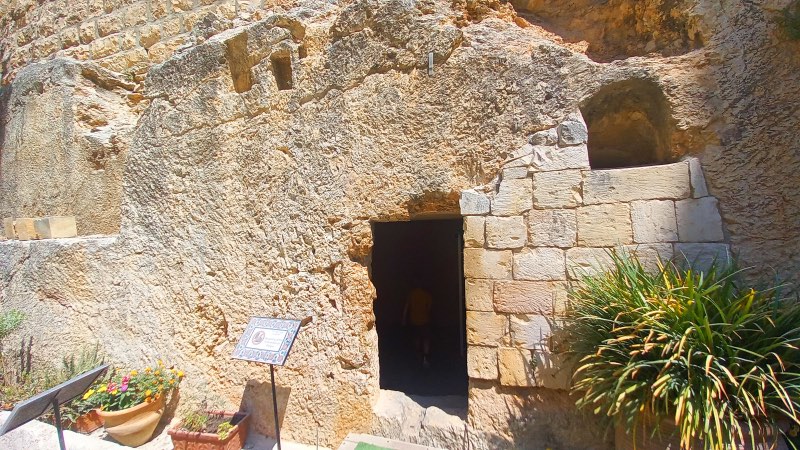
Visiting the garden tomb with genuinely one of our highlights of our time in Jerusalem, and we highly recommend that you stop here on your walking tour. It is free to enter the garden tomb, and that is likely to take at least 30 minutes to explore and take in this beautiful attraction. The garden tomb has beautiful paths leading through a very well-kept Garden. You can see the Golgotha Cliffs, which some people believe mark the crucifixion site of Jesus. You can also visit the tomb itself and step inside the tomb to see the place where people think that Jesus was laid to rest. The garden tomb has a beautiful tranquil ambiance, and there is also a lovely gift shop. After exploring the garden tomb, head back down to the Damascus gate, walk through the gate, and start walking South into the old city.
Open from 8.30am – 5pm.
August closed Sunday and Mondays.
Other months only closed Sunday.
3 Hidme Falafel

After you walk through the Damascus gate, you will see some Market stalls, and the path leads down a small hill to a fork Junction, and you will see a small Street side Falafel shop. They sell fresh local Falafel sandwiches, which are garnished with heaps of salad and sauces. If you’re already starting to work up an appetite, then we recommend stopping here to sample some of the best falafel in The Old City.

Being a small Street side stall, the quality is high, and the prices are low. It costs 12NIS (£2.50 or $3) for a Falafel Sandwich (which is great for Jerusalem). From here, take the road to the right (Beit Habad Street) and walk towards the Church of the Holy Sepulcher.
4 The Church of the Holy Sepulcher

We highly recommend stopping at the Church of the Holy Sepulcher . This is the other main contender for the crucifixion and burial site of Jesus. The Church of the Holy Sepulcher is a very impressive, large, and Grand church with many sanctuaries, altars, and beautiful historical artwork. In the morning, the Church of the Holy Sepulcher is relatively quiet, and this is a lovely time to explore. However, it can get very busy later in the day, and it can be quite an intense experience. Just as you head into the entrance of the Church of the Holy Sepulcher, you will see a stone slab on which they believe Jesus was laid after he was crucified.

To the right, you will see some steps, and if you go up the steps, you can see an altar which stands at the place they believe Jesus was crucified. This is called the place of Golgotha. If you head back down the steps and walk around the corridors of the church, you can find the tomb where they believe Jesus was laid to rest. During the day, it is possible to enter The Chapel at the tomb, light a candle, and place your hand on the stone slab that covers the tomb. If you wish to do this, you need to be prepared to queue for at least 20 minutes, and during busy seasons, it may take much longer than this. The Church of the Holy Sepulcher is a relatively conservative church, so we recommend dressing modestly and respectfully (this applies to both men and women).
5 Muristan Market

After you exit from the Church of the Holy Sepulcher, head south to the Muristan Market. This is a beautiful and historic Market selling a range of street food, gifts, clothing, and there are also some more upmarket restaurants in this area. On average, prices in this market are a little bit higher than other places around Jerusalem, and you do need to be willing to barter if you want to get a fair price. Even if you are not buying something, this is a very beautiful walk, and if you follow the street through the market, you can get to the Tower of David.
6 The Tower of David

After you’ve explored the market, you can see the Tower of David, which is situated at the Jaffa gate on the west side of the Jerusalem Old City. If you’re interested in learning more about the history of the old city, it costs 50NIS (around £10 or $12) for an adult ticket to explore the Tower of David. You can get very beautiful views of the Tower of David from the streets around this area. The Tower of David is also surrounded by plenty of small shops, Market Restaurants, and Street Food.
7 Visit Teddy’s Park

If you have the energy, and especially if you are traveling with kids, we highly recommend walking across the road at Jaffa gate to see Teddy’s Park. This is a beautiful Green Park situated just outside the west of the old city wall. This park has water fountains which are beautiful for cooling off, and kids come here to play. Our kids really enjoyed playing in these fountains.
There are also grass slopes next to the Fountain which allow you to sit back and supervise your kids while they play. The water fountains run for 30 minutes every 30 minutes, so if the water is not running when you arrive, you will not need to wait for more than half an hour before they come on again. If you plan to do this with your kids, we do recommend bringing a towel and a change of clothes and remember sun protection because this is a pretty exposed location.

8 Western Wall

After spending some time at Teddy’s Park, head back into the old city through the Jaffa gate and walk East, following the route until you reach the Western Wall. The Western Wall is a very interesting and unique part of the Jerusalem old city. This is one of the most revered and important sites for Jews. The Western Wall is the only remaining part of the Jewish temple dating back to the second temple period. This part of the temple wall was fought to be built by Herod the Great around 19 B.C.
Although this is a very important and significant site for Jews, we found the Jewish people here to be very friendly and welcoming, and we are allowed to enter the prayer and worship areas. We even visited with our kids, and our kids were welcome in the worship area too. It is free to enter the Western Wall. In order to enter the Western Wall, you do need to go through a security checkpoint, which involves putting any bags or belongings through an X-ray scanner.
9 Hezekiah’s Tunnel

After exploring the Western Wall, walk south until you reach the city of David. The city of David is a national park situated to the south of the Jerusalem Old City. You can buy tickets for Hezekiah’s tunnel at the city of David Visitor Center. Once you have purchased your ticket, you need to take a 5-minute walk down the hill following the signs to reach the entrance of Hezekiah’s tunnel. There is someone who will check your ticket, and then you can follow the route down through Warren’s shaft until you reach the entrance of the water tunnel.

If you don’t fancy getting wet, there is no alternative route called the Canaanite tunnel, and there are clear signs in English to help you find the right way. Hezekiah’s tunnel is a long and fascinating water tunnel, 533m, and over 2,700 years old. This fascinating water supply has a long history and supplied the city with water in times of siege. You can walk all of the way through the tunnel. There are a couple of sections of deep water at the start and end. Most of the walk through the tunnel the water is around ankle deep.
- Adult ticket: 28NIS (around £6 or $8)
- Child ticket (5 – 18 years old): 14NIS (around £3 or $4)
- Under 5 year old FREE
This is not suitable for anyone with mobility issues. In our opinion, this is one of the best activities in Jerusalem for kids. When you reach the end of the tunnel, you can either take a shuttle bus back up to the visitor center for 7NIS. Alternatively, there is a local bus stop, and you can jump on the bus all the way back up to the Jerusalem Old City (bus 286 goes back up the hill, and you can take this bus all the way to Lion’s Gate, which is the next stop on this walking tour).
10 Garden of Gethsemane

The Garden of Gethsemane is a very peaceful and beautiful garden. Although it is not possible to walk through the trees, there is a small path around the circumference of the garden allowing you to immerse yourself in the beauty and atmosphere of this unique place. Some of the olive trees in this preserved garden date back to 1092. It is free to visit the Garden of Gethsemane.
- Summer (April – September): 8 am – 6 pm
- Winter (October – March): 8 am – 5 pm
11 Visit the Mount of Olives
Check out our full visitors guide to the Mount of Olives

After visiting the Garden of Gethsemane, there is an optional detour where you can walk up the Mount of Olives. This is an amazing place to get a view over the Jerusalem Old City, and it is also a wonderful place to go and see the sunset. The walk from Gethsemane to the peak of the Mount of Olives is around 600 m, and the path leads up a relatively steep hill, so we only recommend doing this if you have some spare energy. There is no alternative route where you can get a bus to the peak of the Mount of Olives if you’re running out of energy.
You can take buses to the peak of the Mount of Olives from Shamouil Road at the northeast corner of the Old City (we marked the location of the bus stop on the map). Buses cost 5.5NIS per person (roughly £1 or $1.20). Bus 275 or 255 goes up Mount of Olives (255 follows a less direct route and 275 follows a more direct route). Alternatively, a taxi up the Mount of Olives is likely to cost around 20NIS – 30NIS (roughly £4 – £6 or $5 – $8).
12 Walk the Via Dolorosa

After visiting the Garden of Gethsemane, we recommend heading back into the old city through the Lions Gate on the East Wall. If you follow the road, you join the route of the Via Dolorosa (Latin for “Sorrowful Way”). This is thought to be the route that Jesus walked to reach the point of Golgotha where he was crucified. Along the Route, you can see 14 different stations, which represent different events that occurred on Jesus’s walk.
The Via Dolorosa officially starts close to the Church of condemnation at the Umariya Elementary School, near the location of the former Antonia Fortress. Each of the different stations along the walk has an information sign so that you can learn more about the history and significance of each point of this route. We have marked on the route on the map, which leads all the way back to the Church of the Holy Sepulchre. This also marks the end of a Jerusalem walking tour. From here, you can either head north back to the Damascus gate or go back to your accommodation by the most convenient route.
What do you need to pack for a walking tour of Jerusalem?
Here is a short packing list to help you prepare for your Jerusalem walking tour. This is not a comprehensive list, but rather a list of important things to help you get started:
- Comfortable shoes
- Loose light clothing
- Scarf (for temples and churches)
- Water bottle
- Small day bag
- Sun protection (umbrella, sunscreen, or hats)
- Phone with offline maps or mobile data
- Some cash (be careful of your wallet or purse – don’t carry too much cash)
What is the best time to do a walking tour around Jerusalem?

If you plan to do a Jerusalem walking tour, we recommend starting nice and early in the morning. Even during the summer, the mornings are relatively cool, especially if you’re starting around 6:00 a.m. or 7:00 a.m. The old town is also particularly tranquil and beautiful at this time, and you will find certain places are already open.
For example, the Church of the Holy Sepulcher has Mass services at around 7am or 8am It is worth mentioning that many of the shops and Market stalls do not open till around 8am or 9am, and some of the attractions are not open till around 8am. or 9am. We would also add that it is not too hot in The Old City due to the shade of the buildings. We found that many of the old city streets were shaded for most of the day, even during August.
In terms of the time of year, Jerusalem is relatively quiet during the summer months of July and August. During these months, the temperature is very high. Most days there’s a clear blue sky, and temperatures reach to the high 30s. Alternatively, the Jerusalem High season is between the month of September and November, and it is particularly busy in these months. The weather is very nice, and the average temperatures are lower than the summer months. There is a bit of a travel boom in December (Christmas holidays). In these months, the average temperatures are fairly cold, and Jerusalem can experience rainfall as well.
Is it safe to explore Jerusalem independently by foot?
IMPORTANT UPDATE OCTOBER 2023: We are very sad to learn of the problems in Israel. The FCO currently advises against all but essential travel to Israel including Jerusalem and Tel Aviv. They also advise against all travel in Gaza and the South and in the border regions with Lebanon and Syria in the North. Remember if you travel against FCO advice you will not be covered by your travel insurance policy. If you are currently in these regions follow consulate advice and take care. Keep your eye on the FCO website for updates.

Before we get specific about Jerusalem, it’s important to recognize that any travel experience has inherent risks, and it’s important to research and be aware of the risks before you travel. We have found the information on the FCO website to be particularly helpful and relevant, especially when it comes to advice on safe travel and current affairs.
Israel has a long history of political instability and conflict. However, the Jerusalem Old City is relatively stable, and in general, it is safe to walk around. This being said, you do need to be careful and vigilant. There have been some cases of political instability and violence in Jerusalem in the past, and it is possible that such incidents may occur again. As such, we do recommend that you do your own research before traveling to Jerusalem and monitor the local news to be aware of any political instability.
It is also possible that there may be protests and demonstrations during your time in Jerusalem, particularly around sensitive political issues. In such cases, we recommend avoiding these areas and demonstrations and being cautious about attending public events.
In terms of crime, Jerusalem is relatively safe for tourists. The Old City is well-patrolled by police. However, like in any major city, there is always the potential for petty crimes such as pickpocketing and scams targeting tourists. To minimize the risk of becoming a victim of crime, make sure you keep an eye on your belongings, avoid displaying valuable items, and be aware of your surroundings.
Life loving, adventure chasing, Mum of 3 who loves travel. Over 10 years of travel writing experience. Emma now loves to give the best tips to help other travel loving parents plan adventures with their kids. Whether you need to find the best accommodation or just need to know how to pack your bag Emma is that travelling mum who love to help you.

- Privacy Overview
- Strictly Necessary Cookies
- Privacy Policy
This website uses cookies so that we can provide you with the best user experience possible. Cookie information is stored in your browser and performs functions such as recognising you when you return to our website and helping our team to understand which sections of the website you find most interesting and useful. More information about our Privacy Policy
Strictly Necessary Cookie should be enabled at all times so that we can save your preferences for cookie settings.
If you disable this cookie, we will not be able to save your preferences. This means that every time you visit this website you will need to enable or disable cookies again.
More information about our Privacy Policy

10 Wonderful Walking Tours In Jerusalem
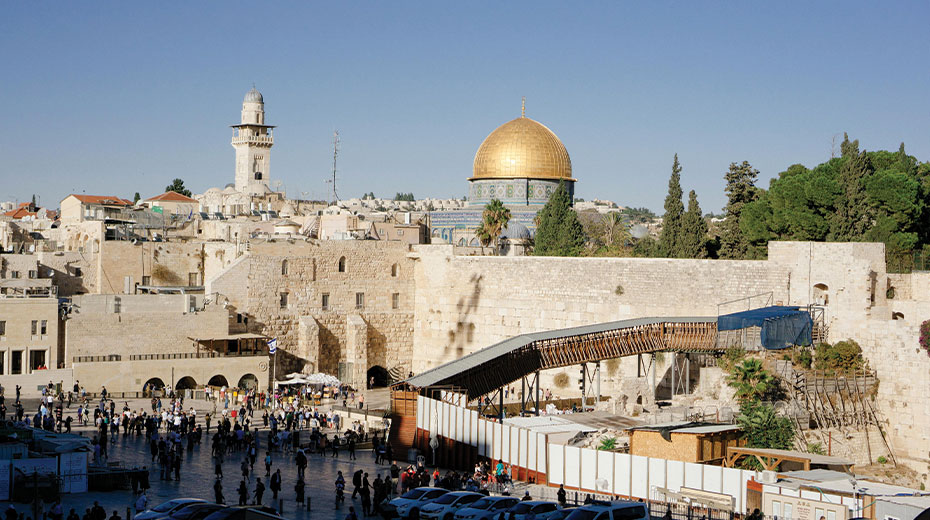
From the time King David made Jerusalem the capital of the Israelite nation in 1003 BCE, the Holy City has become a focal point for the world’s three major monotheistic religions. David wouldn’t recognize the city today. It has greatly expanded beyond the small section his dynasty ruled for 400 years. Today, Jerusalem is Israel’s most populous city, with more than 800,000 residents of diverse ethnicities and religions.
The hilly terrain, stone stairways, and cobblestone walkways in many parts of the city don’t make Jerusalem the easiest place to traverse on foot, but walking tours are the best way to get acquainted with the rich history and culture of this timeless city. So put on sturdy shoes and get started with these 10 options!
1. Free Guided Walking Tours
Every Saturday, the Jerusalem municipality offers 31 different free guided walking tours beginning at the Safra Square municipal complex on Jaffa Street at 10 A.M. Among the areas covered are Nachlaot, Supreme Court and Knesset, Jaffa Road, City of David, King George Street, the Old City, Abu Tor, Mount Zion, Mamilla, First Station and German Colony, Yemin Moshe, and Via Dolorosa
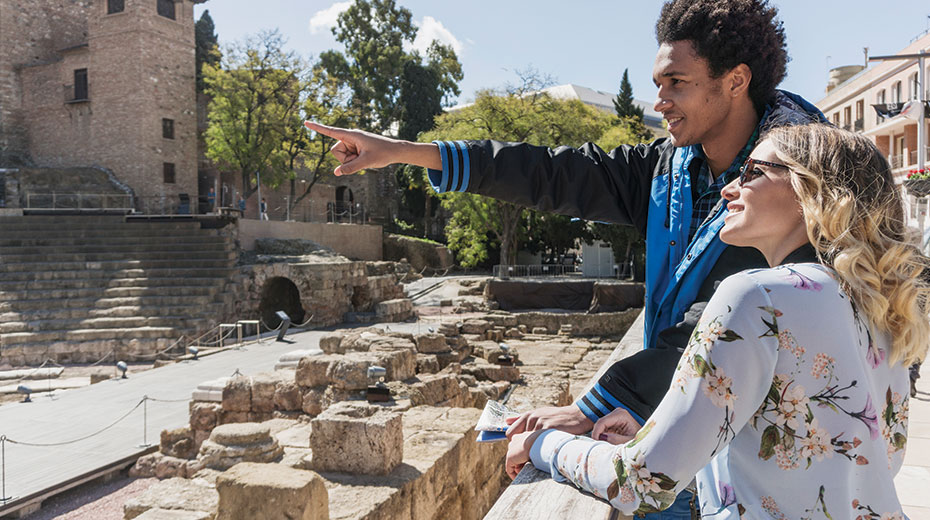
2. Free Self-Guided Walking Tours
The municipality offers 10 downloadable self-guided walking tours of Jerusalem ranging in duration from two to five hours. Choices in the Old City include First and Second Temple ruins, the Jewish Quarter, Muslim Quarter, Valley of the Kings, Via Dolorosa, the northern ramparts, the southern ramparts, Zion to Ararat, Christian sites, and marketplaces.
3. Old City Audio Walking Tours
The Jerusalem Development Authority’s audio walking tour for the Old City, available in English, Arabic, Chinese, Dutch, French, German, Hebrew, Italian, Japanese, Korean, Portuguese, Russian and Spanish, lets you choose from among 20 different guided explorations of churches, synagogues, mosques, historical and religious points of interest, marketplaces, and local eateries.
4. Biblical Jerusalem

Starting and ending at the City of David Visitors Center, this three-hour tour takes you through archaeological excavations of a palace and royal acropolis from the period of the Judean kings, an underground water system from the time of Abraham, and a recently discovered Canaanite fortress that guarded ancient Jerusalem’s main water source, the Gihon Spring. Walking through King Hezekiah’s water tunnel is optional.
5. Walking The Old City And Beyond
Abraham Tours’ four-hour Holy City Tour starts at Jaffa Gate at 11am Sunday to Thursday and goes through the four quarters of the Old City, King David’s Tomb, the Western Wall, the Dome of the Rock, Al Aqsa Mosque, Via Dolorosa, Church of the Holy Sepulcher, and more.
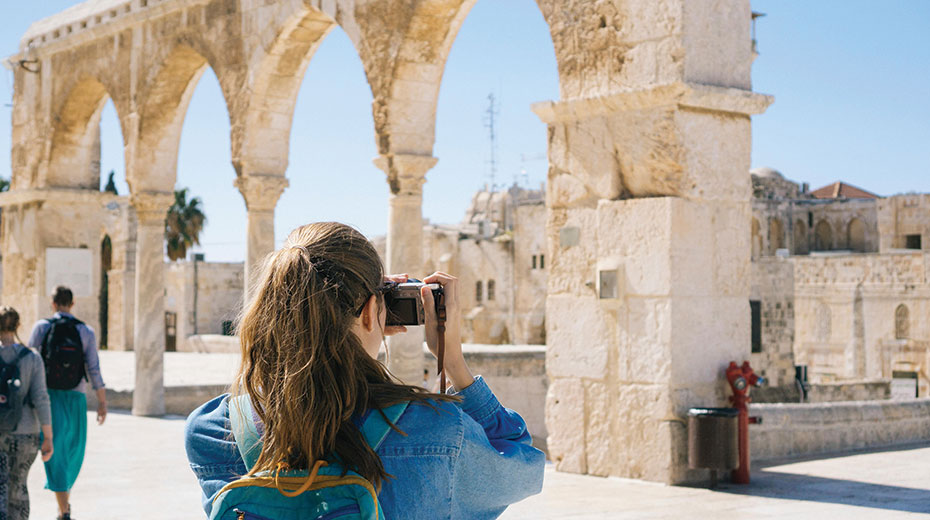
Zion Tours’ three-hour guided tours step off at 10:30 and 2 Sunday to Thursday from the Jaffa Gate. Seven routes are offered from the Old City quarters, Mount of Olives to Gethsemane, Southern Wall excavations and Herodian Quarter, rooftops and underground passages, Machane Yehuda market and Meah She’arim, City of David and Zion Gate, and the Old City Walls. Each requires a minimum of three participants so bring your friends along for the fun!
6. Machane Yehuda Marketplace
Dating from 1930, the downtown “shuk” is a favorite with tourists because there’s so much to see, hear, taste, touch, and smell within a few blocks. After the shops close for the day, come see how the metal shutters are transformed into a street-art gallery.
Established in the 1920s, Rehavia was Jerusalem’s first planned garden neighborhood. Leafy Rehavia, which includes the Prime Minister’s Residence and several landmark buildings, features streets named after Jewish scholars and poets from the Golden Age of Jewish culture in Spain. Explore it on a three-hour walking tour offered by Tanach Tiyulim.
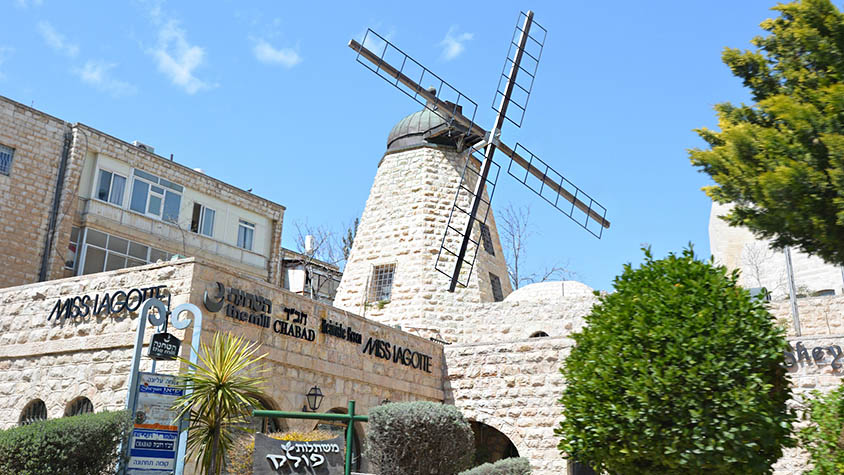
8. Picture Jerusalem
Given the countless iconic images in Jerusalem, it’s not surprising that several professional photographers and tour companies offer walking tours designed to show participants the best sites and angles for taking memorable pictures. A few options include Israel Photography Tour with Laurie Cohen, Photo Tour Israel one-on-one half-day workshops with Yahel Herman, and Machane Yehuda photo workshops with Yehoshua Halevi.
9. German Colony And Greek Colony
Learn the history of these trendy Jerusalem neighborhoods built in the 19th and 20th centuries and anchored by Emek Refaim Street. They’re just 2 of the 24 walking tours of Jerusalem neighborhoods in English offered twice a week by licensed tour guide Miriam Safira Simon. Tours usually take place on Tuesday and Thursday mornings starting at 9:30 A.M .and ending at 12 P.M.
10. Mount Herzl National And Military Cemetery
Named after Binyamin Ze’ev (Theodor) Herzl, the visionary of the Jewish state who is buried here, the terraced and meticulously landscaped Mount Herzl is the final resting place of Israeli presidents, prime ministers, and other dignitaries, as well as Israeli soldiers and police officers. Tanach Tiyulim offers a walking tour replete with stories of the famous, the heroic, and the anonymous statesmen and soldiers buried here.
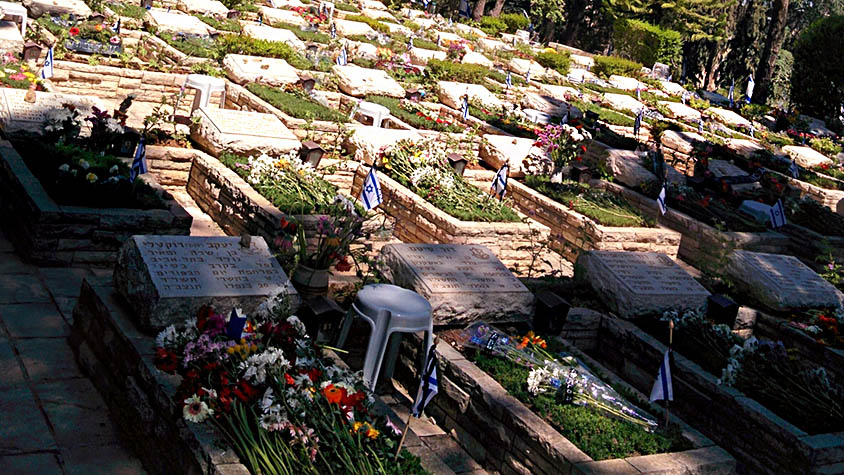
PHOTO: Abigail Klein
Mishkenot Sha’ananim
Team israel stuns baseball world’s best, you may also like, airlines flying to israel now and those returning..., stroll jaffa alleys, masada herod’s palace, hurva synagogue, qumran scroll cave, greece: patmos | the end of the world..., israel: caesarea maritima | an ancient sea port, tabgha mosaic, belvoir fortress, sepphoris | the mosaic city, the “ornament of....
This website uses cookies to improve your experience. We'll assume you're ok with this, but you can opt-out if you wish. Accept Read More
THE BEST Jerusalem Self-Guided Tours
Self-guided tours & rentals in jerusalem.
- Cultural Tours
- Multi-day Tours
- Historical & Heritage Tours
- Self-Guided Tours & Rentals
- Up to 1 hour
- 1 to 4 hours
- 4 hours to 1 day
- 5.0 of 5 bubbles
- 4.0 of 5 bubbles & up
- 3.0 of 5 bubbles & up
- 2.0 of 5 bubbles & up
- The ranking of tours, activities, and experiences available on Tripadvisor is determined by several factors including the revenue generated by Tripadvisor from these bookings, the frequency of user clicks, and the volume and quality of customer reviews. Occasionally, newly listed offerings may be prioritized and appear higher in the list. The specific placement of these new listings may vary.

1. ScaVentures! Have fun, explore and discover!
Keep the fun going with other experiences in the area.

Tel Aviv Pub Crawl

Masada, Ein Gedi, and The Dead Sea from Tel Aviv

Self-guided Graffiti tour in Tel Aviv in your own time and your own pace

Dead Sea, Masada and Ein Gedi Day Tour from Tel Aviv

Day Trip: Masada Sunrise, Ein Gedi, and Dead Sea from Tel Aviv

Tel Aviv: Carmel Market Food Guided Tour with Expert Guide

Culinary Market Tours - for people who love to eat

Guided Pub Crawl Night Tour at Tel Aviv

Petra 2-Day Tour from Tel-Aviv

Tel Aviv Highlights Bike Tour

Best of Tel Aviv and Jaffa Walking Tour - 1 Day

Dead Sea, Masads at Sunrise and Ein Gedi Tour from Tel Aviv

3-Day Petra and Wadi Rum Tour from Tel Aviv

2-Day Petra Tour from Tel Aviv

Hebron Dual Narrative Tour from Tel Aviv

Explore Old Jaffa by night - Private Tour

Tel Aviv south Walking tour: Yafo, Shuk Hakarmel and Neve Tzedek

Private tour: Caesarea, Haifa, and Mt. Carmel

Tel Aviv, Yaffo and Tel Aviv Skyline Tour

Private Tour of Jaffa with Passionate Experienced Guide

Haifa and Acre Private Tour

Bicycle Rentals

Discovering downtown Tel Aviv Street art and ancient Jaffa!

Tel Aviv Craft Beers Pub Crawl

From Tel Aviv: Masada Sunrise, Ein Gedi & Dead Sea

2 Day Tour to Petra and Wadi Rum from Tel Aviv

Petra 1-Day Tour from Tel Aviv with FREE Authentic Lunch

Tel Aviv & Old City of Jaffa - Tiny group from Tel Aviv

Pub Crawl Biggest Nightout in TLV with Clubs and Dance Bars
- THE LAND OF ISRAEL TRAVEL COMPANY
- Plan-It Israel
- APRIL TOURS ISRAEL

Old Akko City Walk
Old akko is full of surprises. historical landmarks, hidden alleys, fantastic sea views, underground tunnels, markets, and street food. our self-guided walking tour will take you on a magical journey between all of them, main landmarks on the tour:.
- Treasures in the Wall Museum.
- The eastern wall
- White Market
- El Jazzar Mosque
- Hammam el Basha
- Turkish Bazar
- Humus Said and the Market Street
- The “Khans” (Caravanserais)
- The Ports (Old and New)
- Templar Tunnel
- St. George Church
- Bahai House
- El Shazliya Mosque
- Underground prisoners Museum
- Knights Halls underground complex

WALKING TUOR MAP

The tour is circular. It starts and ends in the Old Akko information center . There are several parking lots nearby (Paid), and excellent public transportation. If you are arriving by train, take bus #3 from the train station. If you are coming for a day-trip from Haifa, you can also use the boat service and start/end the tour at the port. Some minor streets do not appear on GoogleMaps. For smooth navigation, follow the track on Viewranger , or use our map. If you plan to enter several of the landmarks along the walk, consider purchasing a combination ticket .
The Old City of Acre has a unique atmosphere. The natural bay that protected it from the storms has made Acre the central port city in the land of Israel for thousands of years and attracted many rulers over the centuries. Akko is one of the oldest cities in the country. It was founded about 4,000 years ago, but until the Crusader period, it remained a small fishing town.
During the Crusaders era, the city grew substantially, thanks to the Europeans, who exploited its enormous potential as a port city. The Third Crusade (Lead by Richard Lionheart ) made the city the capital of the kingdom after they failed to conquer Jerusalem. When the Crusader kingdom collapsed, Acre was destroyed, and only about 200 years later, during the Ottoman period, it was rebuilt and flourished again. The fortifications we see today were built around 1750 by Sheikh Dahar al-Omar , a local Bedouin who was granted by the Ottomans with the title ” Sheikh of Acre, Amir of Nazareth, Tiberias, Safed, and Sheikh of all Galilee”. In 1799 following his successful campaign in Egypt, Napoleon marched north into the land of Israel. His journey north was smooth until he encountered the massive fortifications of Akko. Following a failed siege to take over Akko , Napoleon withdrew, leaving many dead and wounded.
Acre is an ancient port city, full of fascinating archeological finds and important historical sites. But On the other hand, Acre is also a modern city, blessed with lovely beaches and a colorful oriental market with a variety of goods: seafood, fruits, vegetables, fabrics, clothes, and various souvenirs.
HISTORY Of AKKO
OLD CITY SELF-GUIDED WALKING TOUR

“Treasures in the Walls” is a small and charming Ethnographic Museum displaying objects and lifestyles from the 19th & 20th centuries in the Galilee Region. Items on display include furniture, kitchenware, tools, and clocks, as well as reconstruction of old market stores and craft workshops typical to the region. Everything is beautifully displayed in a historic fort built inside the old city walls. A must visit!

The city walls you are walking on were built around 1750 by Daher al Omar on earlier crusader walls. These are the walls that Napoleon could not pass during the siege of 1799. Walking on the walls rewards you with fantastic views of old Akko and the Mediterranean Sea. The most scenic spot is the southern tip. There is no way down from the tip, and you will need to retrace your steps a hundred meters to the wide staircase that descends from the wall.

The white market was established during the 18 th century. It was built on foundations of an earlier market that was destroyed by fire in 1816. The large market then numbered 64 stores and was the largest shopping center in the area. It is named “White Market” because of its white painted walls and the large windows that enable the sunlight to penetrate inside. During the British mandate, it’s importance declined, and the building remained as a remnant of the glorious history of the Ottoman Empire. The building stayed in ruins until it was renovated several years ago and became a compound of small cafés and restaurants.

El Jazar Mosque is one of the most famous buildings in Old Akko. It dominates the city’s skyline, and Its green dome is seen from afar. It is the largest mosque in the country outside of Jerusalem. The mosque was built in 1781 by Al-Jazar, who was the ruler of Acre and northern Israel. It is considered one of the most magnificent buildings that were built in the Land of Israel during the Ottoman period. The mosque is active and holds five daily prayers. It also provides religious classes and other activities.
At the entrance to the mosque stands a magnificent circular fountain built from marble and covered with a beautiful dome. The courtyard has a lovely garden with a marble stone clock.
Tours inside the mosque compound can be prearranged by phone +97249913039 .

El Jazar built the Hammam in 1795 in a traditional oriental style typical to the Turkish Empire in the 18 th -19 th centuries. The entrance to the Hammam serves as a dressing room, the center of which is a marble fountain. This room leads to a row of warm halls. The biggest and fanciest one is octagon-shaped, and the ceiling is a marble dome standing on marble pillars. The bathhouse structure is magnificent and decorated with marble floors and ceramic tiles. It is recommended to watch the spectacular audiovisual show.

The Turkish Bazar Admission: Free. Opening: Daily 10:00-18:00 Location: Richard Lev Ari St. Direction: From the Hamam, turn left and after a few meters, the entrance will be on your left.
The Turkish bazaar of Acre was built in the late 18th century on top of a crusader period compound. During this period, quite a few public buildings were built, and, among other things, the Bazar was established. The purpose of the market was to provide a workplace for various craftsmen who worked in small shops along the small streets. The market was abandoned in 1948 when the IDF conquered Acre. It reopened In 2012, following a restoration project. It is now a vibrant compound filled with Small souvenir shops, art galleries, cafes, and gourmet restaurants.

The main market street of Akko is a delight for street shopping. Fresh products such as fish, fruits, and vegetables. Traditional Arab street food like Falafel, Baklawa, and Humus. And other small shops of all kinds. One of the most famous spots in the street is Hummus Said, who is rated by many as the best Hummus in Israel. Traditionally, Hummus is a breakfast dish that the hard-working class used to eat before heading out to work. This tradition is well reflected by the unique opening hours of this restaurant, 05:00 AM – 2:30 PM. People from the area arrive very early in the morning to buy fresh Hummus. (The fresher, the better!), and it is not uncommon to find a long line of people outside the restaurant’s door.

The main reason to visit the port is the fantastic view it gives towards the city. The best spot is at the very end of the breakwater.

What you see here, are remnants of the Crusader period port from 800 years ago. ( Further Reading )

The Templars were a military religious order nominated by the Pope. Their task was to help pilgrims who came from Europe to visit the holy places. They first resided in Jerusalem, on the Temple Mount, hence their name. Following the conquest of Jerusalem by Saladin in 1187, the Templars established their seat in Acre and began to build their district in the southwestern part of the city. Here, at the western end of the tunnel, stood their central citadel (Now sunk underwater).
In 1994, construction workers accidentally discovered the tunnel. The 350-meter tunnel probably served as a strategic underground passageway between the citadel and the town. After extensive excavations, the tunnel was opened to the public in 1999. The bottom is hewn in natural rock, while the upper part is built from stones creating an arched ceiling. The walk in the tunnel is a great experience.
END THE WALKING TOUR HERE OR CONTINUE?
The exit from the tunnel is at the backside of Han Al Umdan, near the port and the market street. You can end your tour here and continue to ramble in the market and the port. Or continue with the walking tour.

Until now, we moved between the famous landmarks of old Akko, along the main streets and with very short walking distances. The 2 nd half of the tour has a different character. It involves more walking and takes you into the less touristic parts of the old town. You will walk in narrow stone arched alleys and visits smaller and lesser-known landmarks.

The Greek Orthodox Church is very modest and can be missed easily. It is considered the first Christian place of worship established in Akko, during the Ottoman period. The church was built in 1545 and has since served as a gathering place for Greek-Orthodox Christian residents and tourists. In 1631, the monk Eugene Roja, who visited the city of Acre, wrote about the Greek Orthodox Church, which is why it is believed to be one of the oldest churches in the town.

Bahai House Admission: Free. Opening: The house is under preservation work and can be seen only from outside. Location: Zalman Hazoref St. Direction: Continue on the same street for a few meters until you arrive at a large plaza. Just after the plaza, the house will be on your right.
Allah lived for seven years in a room in this building after he was released from the Acre prison. Here he wrote the Kitáb-i-Aqdas (the central book of the Bahá?í Faith) in 1873, and his son’s wedding was held in this building. The building is now (2020) going through and extensive preservation project. Hopefully, it will be open to visitors in the future.

Nur a-Din El Yashruti, established the Sufi order (Islamic mystic sect) in Akko. He arrived at the city from Tunis in 1849 and established here their word center. In 1862 he opened up the El Shazliya as a Zawayia (A type of Islamic school). It is not possible to visit inside, but you should come here for the delightful sight of the Blue dome of the Zawayia with the White dome of Hamam el Basha peaking behind it.

The Acre Fort was built during the Ottoman period on the foundations of a 12th century Crusader fortress. It served as the governer’s office, and later also as a prison. During the British Mandate, the fortress served as the central prison in northern Israel. Several Jewish resistance organizations struggled the Mandatory government to establish a Jewish state in the land of Israel. The first prisoner was Ze’ev Jabotinsky , the Jewish Defense Commander in Jerusalem. He was arrested in 1920, together with nineteen members of the city’s protectors. Until 1948 hundreds of resistance fighters were imprisoned here, and 9 were executed by hanging. On May 4 th, 1947, a group of resistance fighters broke through the prison walls and freed 27 prisoners. Read more about it here .

Knight’s Hall underground complex Admission: 21 NIS. Opening: Daily 08:30-17:00 Location: Old Akko information center Direction: Walk east past the museum until you reach a wide stone staircase on your right. Go down the stairs and arrive at the visitor center (Where the walk started)
Under the area of the fortress (Now the underground prisoners’ museum), The remains of a Crusader Hospitaller Citadel are found and archaeologists had gradually unearthed the citadel for decades. Visiting the huge halls takes you to the stories of Akko during the Crusader period. It is One of the most impressive sites in the city.
Written by Erez Speiser

IMAGES
VIDEO
COMMENTS
Map Self-Guided Walking Tour of Jerusalem's Old City . The Ancient Walled City. Jerusalem has been conquered by a great number of civilizations over the centuries including the Babylonians, the Romans, the Arabs, the Crusaders, the Turks, and the British. When you look at the old walled city today you are looking at the walls built later in ...
Our Self-Guided Walking Tour in the Old City of Jerusalem will take you to narrow picturesque alleys, famous sites, and interesting, lesser-known historical landmarks. MAIN LANDMARKS ON THE THS TOUR CHRISTIAN QUARTER: Latin Patriarchate of Jerusalem Armenian Ceramic Center Monastery of Saint Saviour Ethiopian Patriarchate El-Khanqa Street Church of the Redeemer (Viewpoint) Mursitan JEWISH ...
Sightseeing Walk: Mount Scopus Walking Tour. Sightseeing Walk: Muslim Quarter & Temple Mount Tour. Sightseeing Walk: Bethlehem Walking Tour. Sightseeing Walk: Mount Zion Walking Tour. Discovery Walk: City Center Shopping Walk. Article (B): 16 Old & New Things to Buy in Jerusalem. Article (B): 12 Best Things to Do in Jerusalem, Israel.
The old town area of Jerusalem is perfect for a self-guided tour, as it includes a variety of historically relevant religious sites, and it's fairly easy to walk from one point to the next. That said, you should keep in mind that the entire distance of this tour is approximately 1.75 miles, so while it's not an especially long walk, you ...
The municipality offers 10 downloadable self-guided walking tours of Jerusalem ranging in duration from two to five hours. Choices in the Old City include First and Second Temple ruins, the Jewish Quarter, Muslim Quarter, Valley of the Kings, Via Dolorosa, northern ramparts, southern ramparts, Zion to Ararat, Christian sites and marketplaces. ...
MOUNT OF OLIVES SELF-GUIDED TOUR Our walking tour is divided into four sections: The Ridge of the Mountain: We will visit two lesser-known churches and enjoy the best view of Jerusalem. The Jewish Cemetery: We will learn about key figures from the early days of Zionism that are buried here. The Slope of the Mountain: We will go down from the ridge to the Kidron Valley and visit on the way ...
Once you arrive in Jerusalem, most of the sites on the itinerary below are in and around the Old City. You can draw a circle with a 3/4-mile radius and hit all but 3 of the sites on the list. Whether you take a regular tour or do it on your own, Jerusalem's Old City is done on foot. There is no way around it.
Historical landmarks, Hidden alleys, fantastic sea views, underground tunnels, markets, and street food. Our Self-Guided walking tour will take you on a magical journey between all of them. Dive with us into Israel's historic cities with our Self-Guided Walking Tours. Explore hidden gems and secret spots, alongside the well-known landmarks.
In this article, we are going to share an independent, self-guided Jerusalem walking tour for 2024. The aim of this walking tour is to help you see all of the best attractions around the old city. We have designed a route that maximises attractions and sights but minimises your distance. Important: There are a few challenges walking around ...
The municipality offers 10 downloadable self-guided walking tours of Jerusalem ranging in duration from two to five hours. Choices in the Old City include First and Second Temple ruins, the Jewish Quarter, Muslim Quarter, Valley of the Kings, Via Dolorosa, the northern ramparts, the southern ramparts, Zion to Ararat, Christian sites, and ...
Guide Name: Jerusalem Old City Walking Tour. Guide Location: Israel » Jerusalem (See other walking tours in Jerusalem) Guide Type: Self-guided Walking Tour (Sightseeing) # of Attractions: 13. Tour Duration: 3 Hour (s) Travel Distance: 5.0 Km or 3.1 Miles.
399. Visit the Holy Land sites of Nazareth and the Sea of Galilee on this full-day guided tour from Jerusalem. Travel to the city of Nazareth, described in the New Testament as the childhood home of Jesus. See popular Holy Land sites like the Basilica of the Annunciation and Mt. Tabor, the site of the Transfiguration of Jesus.
Tour Duration: 1 Hour (s) Travel Distance: 2.3 Km or 1.4 Miles. View all walking tours in Jerusalem, Israel. Self-guided walking tour: Jewish Quarter Walking Tour in Jerusalem, Israel. The detailed walk route map can be downloaded to your mobile device for turn-by-turn travel directions.
Masada, Ein Gedi, and The Dead Sea from Tel Aviv. 231. Historical Tours. 6+ hours. Discover some of Israel's memorable highlights on a one-day tour that transports you to Masada, the Ein Gedi nature reserve…. Free cancellation. from. $79. per adult.
This self-guided walking tour takes us on a journey to the beginnings of the Jerusalem, to the city of David, Solomon and the Kings of Judah, at the center of which stood the Holy Temple - the spiritual heart of the Jewish people. ... Our tour route will take us among the ruins of Jerusalem's magnificent past from the First and Second Temple ...
Guide Name: Muslim Quarter & Temple Mount Tour. Guide Location: Israel » Jerusalem (See other walking tours in Jerusalem) Guide Type: Self-guided Walking Tour (Sightseeing) # of Attractions: 12. Tour Duration: 2 Hour (s) Travel Distance: 2.1 Km or 1.3 Miles. Author: vickyc. Sight (s) Featured in This Guide: Lions' Gate.
Walking Tours In Israel Travel with our Self Guided Unique Hiking Navigation Program Or Let One Of Our Tour Guides Lead You Through The Trails Of Israel. ... Join us and explore the joys of walking the hills of Israel your way with other like-minded walkers. Read More >> Booking & Information: 0723931583 WalkInnIsrael - Travel Israel;
The mosque will be on your left. El Jazar Mosque is one of the most famous buildings in Old Akko. It dominates the city's skyline, and Its green dome is seen from afar. It is the largest mosque in the country outside of Jerusalem. The mosque was built in 1781 by Al-Jazar, who was the ruler of Acre and northern Israel.
Walk along the northern part of the Old City walls in this self-guided walking tour. login; en; AA+. accessibility settings. color blind; height contrast; visually impaired; increase size 0 %decrease size; links underline; reset all; ... Get a guided audio tour JDA (Jerusalem Development Authority) free app. Tour Hours. Sundays - Thursdays ...
Tour Duration: 1 Hour (s) Travel Distance: 1.7 Km or 1.1 Miles. View all walking tours in Jerusalem, Israel. Self-guided walking tour: Christian Quarter Walking Tour in Jerusalem, Israel. The detailed walk route map can be downloaded to your mobile device for turn-by-turn travel directions.
On this self-guided walking tour, follow the path of Jesus who came to Jerusalem on the eve of Passover, accompanied by his disciples. The events that took place during the week following his arrival in the city until his crucifixion and resurrection have become the foundations of the Christian faith.
Guide Name: Mount of Olives Walking Tour. Guide Location: Israel » Jerusalem (See other walking tours in Jerusalem) Guide Type: Self-guided Walking Tour (Sightseeing) # of Attractions: 11. Tour Duration: 1 Hour (s) Travel Distance: 1.7 Km or 1.1 Miles. Author: vickyc. Sight (s) Featured in This Guide: Tomb of Zechariah.
Guide Name: Bethlehem Walking Tour. Guide Location: Israel » Jerusalem (See other walking tours in Jerusalem) Guide Type: Self-guided Walking Tour (Sightseeing) # of Attractions: 8. Tour Duration: 1 Hour (s) Travel Distance: 1.6 Km or 1 Miles. Author: vickyc. Sight (s) Featured in This Guide: Manger Square (Bethlehem)
Want to visit this sight? Check out these Self-Guided Walking Tours in Jerusalem. Alternatively, you can download the mobile app "GPSmyCity: Walks in 1K+ Cities" from Apple App Store or Google Play Store. The app turns your mobile device to a personal tour guide and it works offline, so no data plan is needed when traveling abroad.